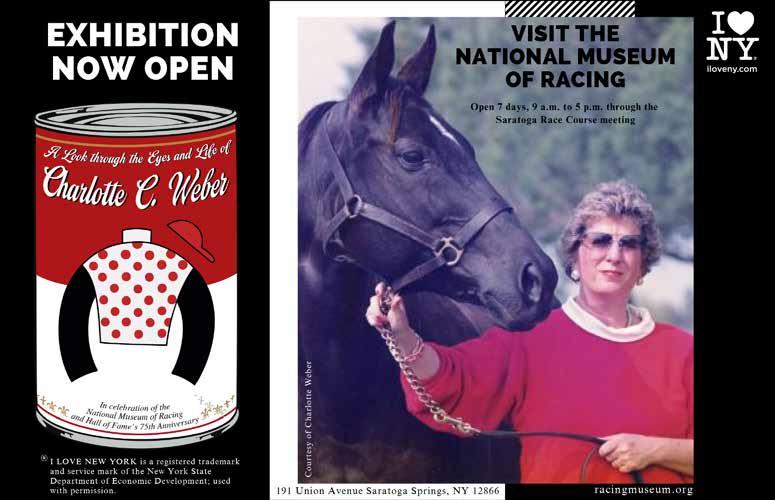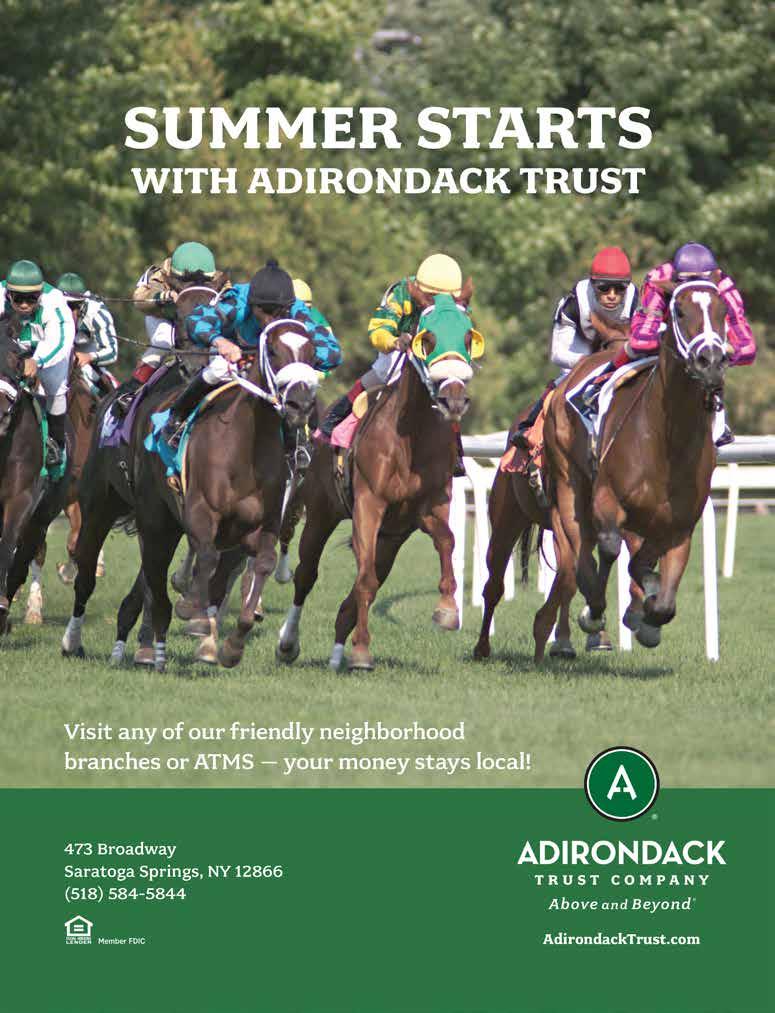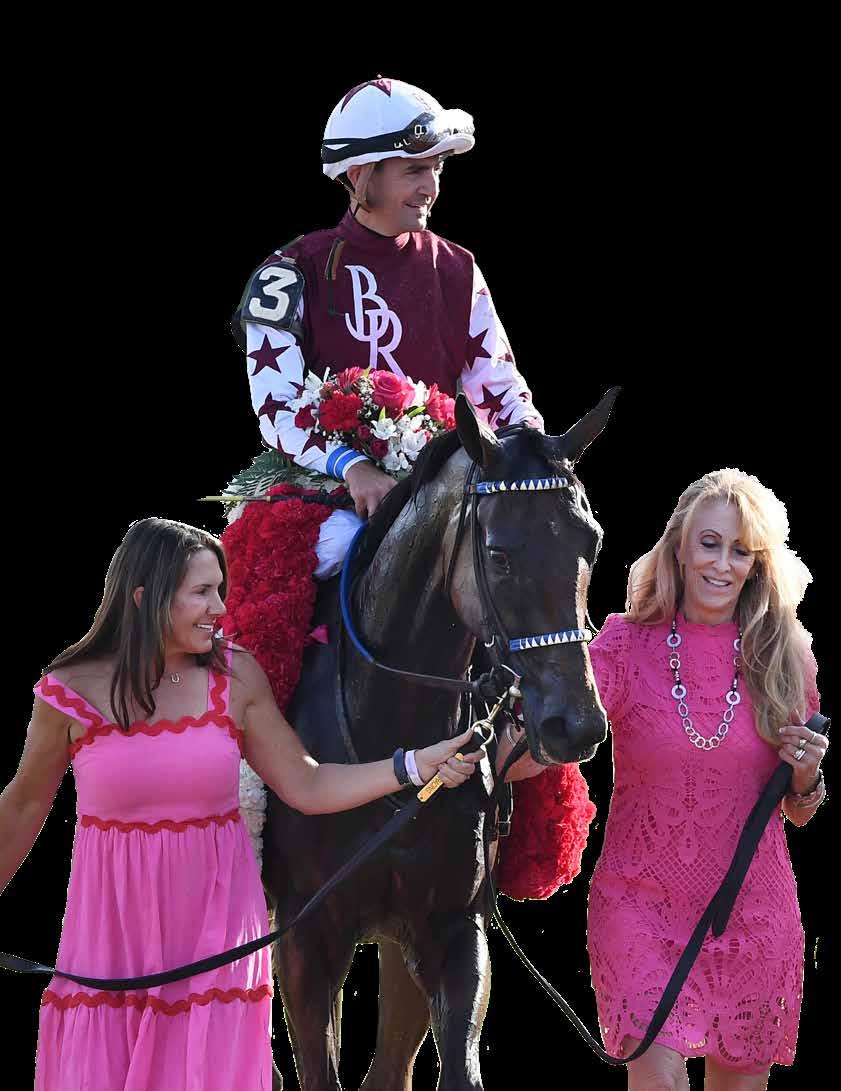


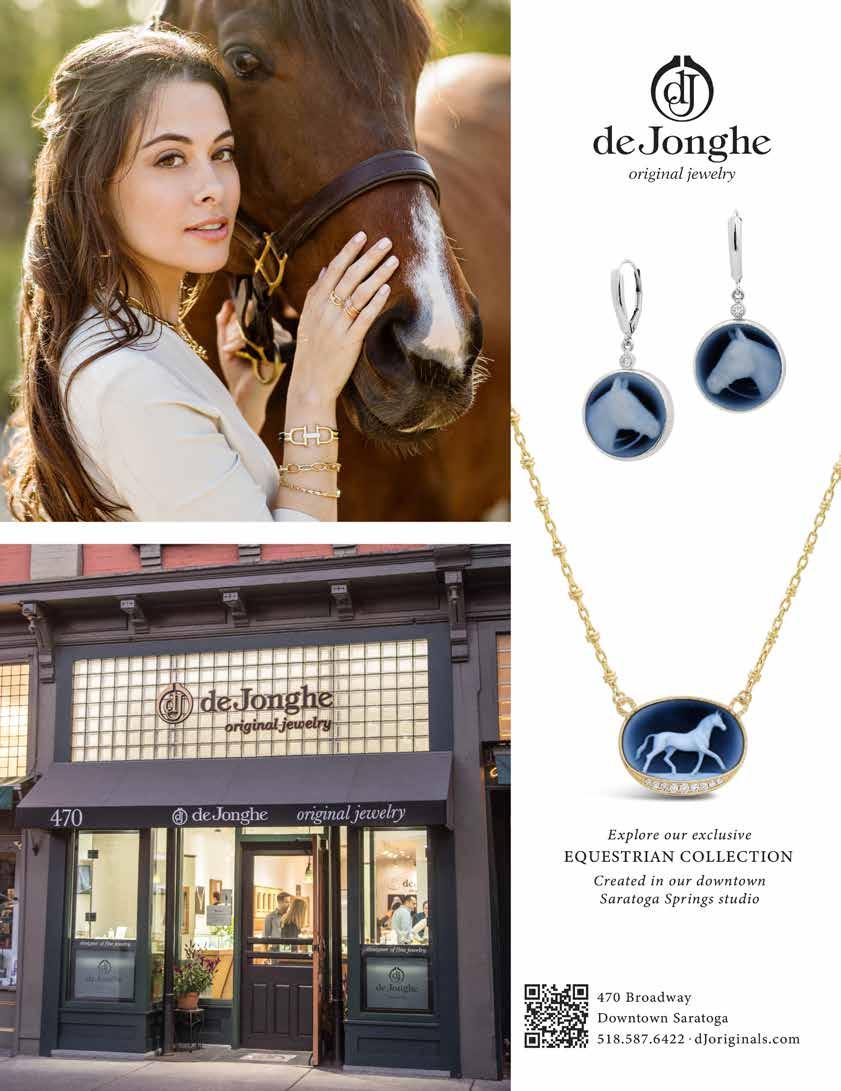









Marion E. Altieri, EDITORIAL DIRECTOR
by Nick Glasser
Every Summer in Saratoga is full of promise and giddy anticipation: the delight of meeting new people who share our passion for horsesn and racing is always a joy. Just being here, and learning more about Equus Caballus (our favorite species), and the people blessed to work and live with them makes our Saratoga Summer like attending Summer School –but with Popsicles. ��
In this issue, we’ll give you the skinny on the track, things you need to know in order to navigate and get the most out of your days at “The Spaaaaaaaa.” ref., Tom Durkin
Facts and figures: the NYRA Calendar and preview of the Fasig-Tipton Sales in August, in concert with the manic buildup to the Travers -- all encourage race fans to linger, to book a few extra days (or weeks!) at their favorite hostelries.
We anticipate that the second half of this issue will elicit a mixed-bag of thoughts and sentiments: from a history of the horse in Saratoga, through Conformation and exquisite Saratoga cocktails, there’s something for everyone. (Note: Hattie’s refreshing Mojito also will whet your jones for Saratoga-specific potables.)

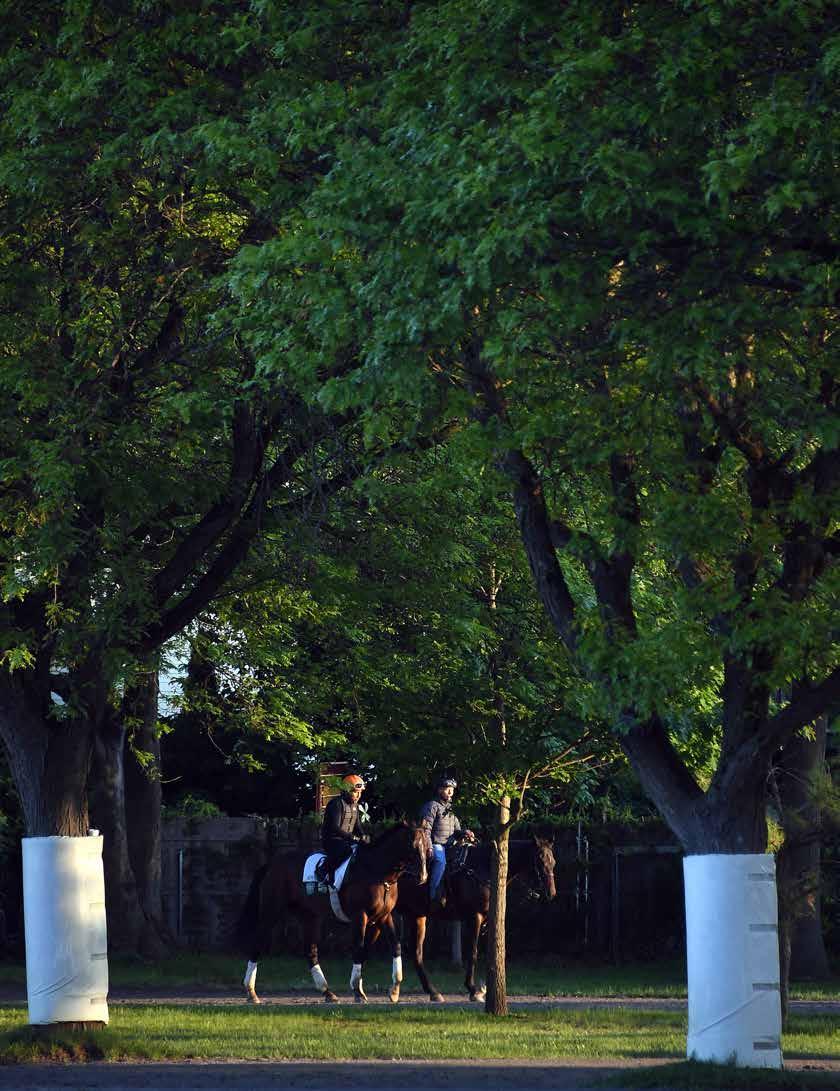
Our

The magnificent Thorpedo Anna sets the Gold Standard, a thought we’ll examine in these pages. (Might she trek here for the fresh air and a race? Who knows -hooves, crossed!)
Great racing rivalries, both historic and fantasy; Part 2 of our Reading Room piece; and the 2025 Hall of Fame Inductees round out the issue. (Ahhh, yes: we would be remiss if we didn’t pay homage to John F. Hendrickson, who joined his beloved wife, Marylou Whitney – now, both sitting ringside on the heavenly oval. This first Saratoga Summer just won’t be the same without the magnanimous Philanthropist, and Friend to All.)
But in John’s memory, we shall carry on, and celebrate his hometown, this track and his utter devotion to our sport, the horses and the people who make it happen.
To quote Harvey Pack -- another late, great member of our Racing Family: “May the Horse be with you.”
OWNER/PUBLISHER
Chad Beatty
EDITORIAL DIRECTOR
Marion E. Altieri
MAGAZINE DESIGNER
Kacie Cotter-Harrigan
ADVERTISING DESIGN
Julia Ettkin
ADVERTISING SALES
Chris Vallone Bushee
Jim Daley
Cindy Durfey
CONTRIBUTING WRITERS
Marion E. Altieri
L.A. Berry
Brien Bouyea
Taylor Flynn
Carol Godette
William G. Gotimer Jr.
Bill Orzell
Stewart White
PHOTOGRAPHERS
Kebal Aleksandra
L.A. Berry
George S. Bolster Collection
Adam Coglianese / NYRA
Francesco D'Amico
Cathleen Duffy
Taylor Flynn
Janet Garaguso / NYRA
Kentucky Derby Museum
Permanent Collection
Joe Labozzetta / NYRA
Angelo Lieto / NYRA
Dom Napolitano / NYRA
Janet Napolitano / NYRA
National Museum of Racing and Hall of Fame
Susie Raisher / NYRA
Georgia Rush
William Strode
Ryan Thompson / NYRA
Walter Wlodarczyk / NYRA.
PUBLISHED BY SARATOGA TODAY
2254 Route 50 South
Saratoga Springs, NY 12866
518-581-2480
saratogaTODAYnewspaper.com
Equicurean® is brought to you by Saratoga TODAY, Saratoga Publishing, LLC. Saratoga Publishing shall make every effort to avoid errors and omissions but disclaims any responsibility should they occur. No part of this publication may be reproduced, stored in a retrieval system, or transmitted in any form or by any means without prior written consent of the publisher. Copyright © 2025. Saratoga TODAY Newspaper.

Photo: Dom Napolitano / NYRA
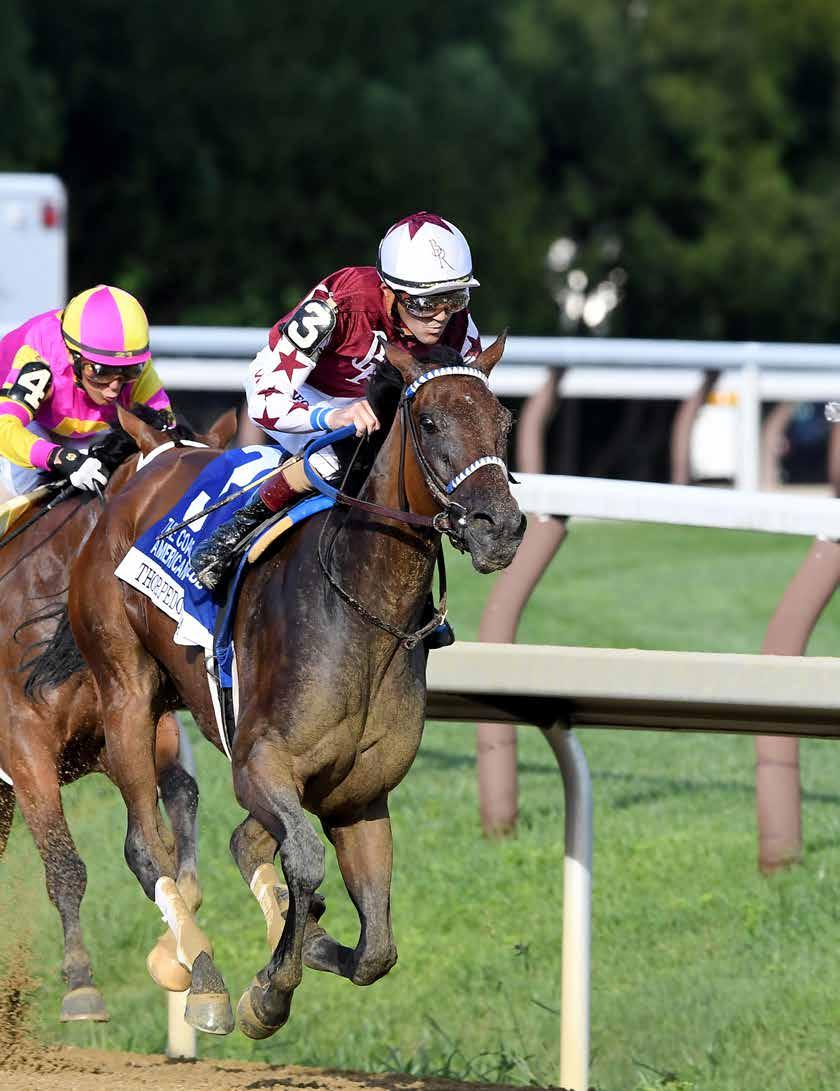
Trunk, Saratoga Outdoors,



Saratoga Summer Meet
JULY 10 - LABOR DAY, SEPTEMBER 1
The summer meet features 40 days of racing.
Summer Meet
Noteworthy Dates: Opening Weekend
July 10-13
Jim Dandy Day
July 26
Whitney Day
August 2
Travers Day
August 23
Noted as one of the “Top 10 Sporting Venues In The World” by Sports Illustrated, Saratoga Race Course is one of horse racing’s most beloved tracks.
With historical ambiance and modern day amenities and style, Saratoga Race Course is the place to find top Thoroughbred horse racing July through Labor Day each year. The 40-day meet draws the top horses, trainers and owners in the world to try their luck at “The Spa."
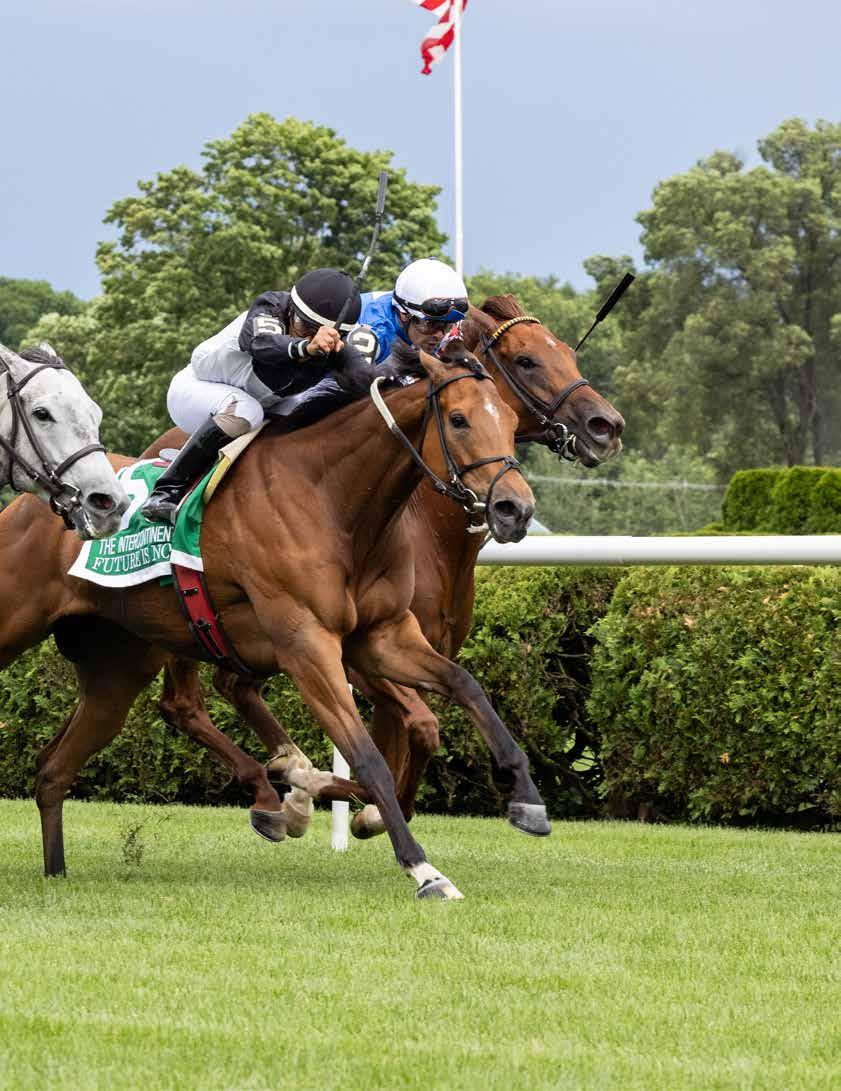

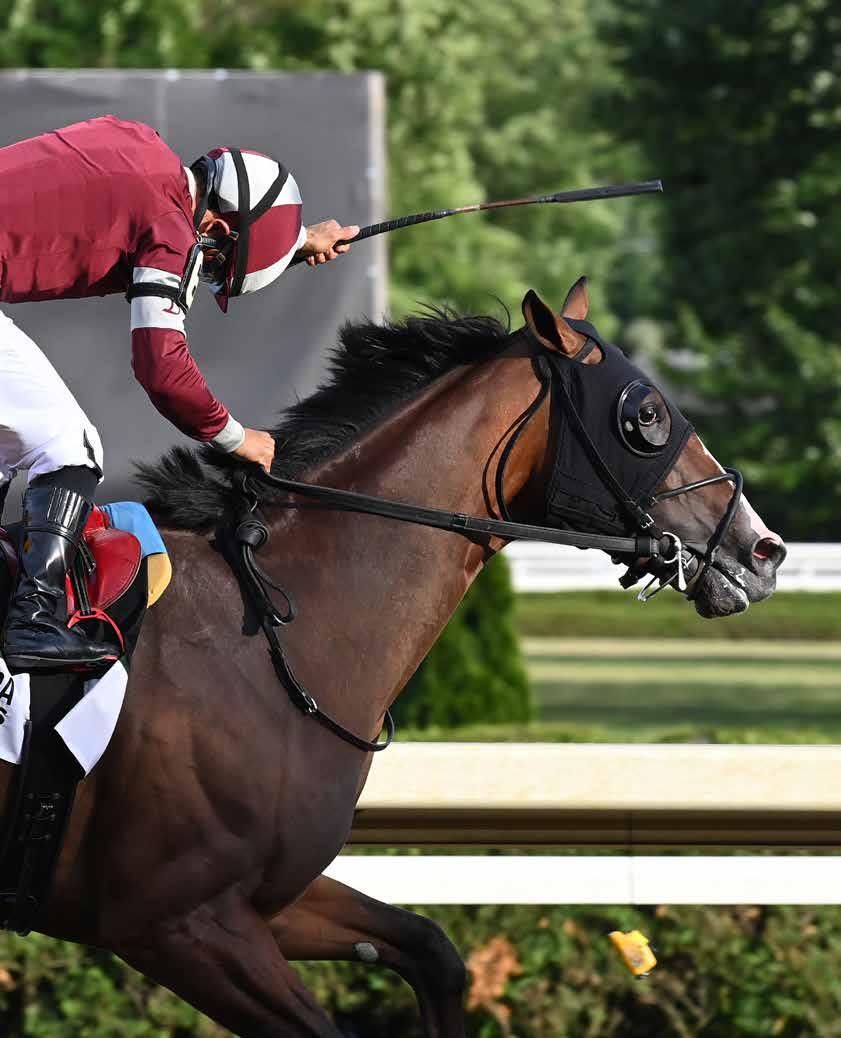
OPENING WEEKEND
July 10 De La Rose (NW GSS in 2024-2025)
July 11 GIII Coronation Cup
July 12 GI Dunkin' Diana
GII Bowling Green
July 13 GIII Quick Call presented by Thoroughbred Retirement Foundation
WEEK 2
July 16 Suzie O'Cain (NYB)
July 17 Rick Violette (NYB)
July 18 GII Shuvee
July 19 GI Coaching Club
American Oaks
GIII Caress
GII Alfred G. Vanderbilt
July 20 GII Honorable Miss
WEEK 3
July 23
GI A.P. Smithwick Memorial
July 24 Curlin presented by Casamigos
July 25 GII Amsterdam presented by Albany Med Health System
July 26 Jim Dandy Day
GIII Lake George presented by Surfside
GII Jim Dandy presented by Mohegan Sun
July 27 GII Glens Falls
WEEK 4
July 30 Johnstone (NYB)
July 31 Evan Shipman Stakes (NYB)
Aug 1 GII National Museum of Racing Hall Of Fame
Aug 2 Whitney Day
GII Saratoga Special
GI Saratoga Derby Invitational
GI Test presented by Ticketmaster
GI Whitney
GII Troy
GI FanDuel Fourstardave
Aug 3 GIII Adirondack
“Every little girl wants a pony. Every woman wants a horse in the 7th at Saratoga.” – Hall of Fame Trainer, the late, great LeRoy Jolley
WEEK 5
Aug 6 Birdstone
Aug 7 Galway
Aug 8 GII Ballston Spa
Aug 9 GII Fasig-Tipton
Saratoga Oaks Invitational
GI Sword Dancer
Aug 10 GIII Mahony
WEEK 6
Aug 13 New York Stallion SeriesStatue of Liberty Division
Aug 14 New York Stallion SeriesCab Calloway Division
Aug 15 Smart and Fancy
Aug 16 Skidmore
GI Alabama presented by Keeneland Sales
Aug 17 Bolton Landing
WEEK 7
Aug 20 GI Jonathan Sheppard Memorial
Aug 21 Albany (NYB) presented by Albany Distilling Company
Fleet Indian (NYB)
Aug 22 Seeking the Ante (NYB) Yaddo Stakes (NYB)
Aug 23 Travers Day
GI DraftKings Travers
GI H. Allen Jerkens Memorial
GII Lake Placid
GI Resorts World Casino Ballerina
GI Forego
GI Personal Ensign
Aug 24 West Point Hdcp (NYB)
Funny Cide (NYB) presented by Rood & Riddle Equine Hospital
WEEK 8
Aug 27 P. G. Johnson presented by Snap On
Aug 28 GIII With Anticipation
Aug 29 Perfect Sting
Bernard Baruch
Aug 30 GI Spinaway
GIII Prioress
GII Flower Bowl
Aug 31 GI Jockey Club Gold Cup
Disco Partner (NW Gr. SS in 2024-2025)
Sept 1 GI Spendthrift Farm Hopeful Saranac (NW of a Gr sweepstakes in 2025)
Win: Your horse must finish first.
Place: Your horse must finish first or second.
Show: Your horse must finish first, second, or third.
Across the Board: Separate win, place, and show wagers of equal amounts on the same horse.
Exacta (box): Pick the first two horses in the correct order. Box it and the horses you select can finish in any order.
Trifecta (box): Pick the first three horses in the correct order.
Box it and the horses you select can finish in any order.
Superfecta (box): Pick the first four horses in the correct order. Box it and the horses you select can finish in any order.
“Boxing” your choices in exacta, trifecta, and superfecta bets makes your wager more expensive but allows you to win if your selected horses finish in any order! In addition, adding additional horses to your wagers raises the price of your ticket, but gives you more chances to win.
BETS WITH MULTIPLE RACES
Daily Double: Pick the winners of two consecutive races.
Grand Slam: Pick a horse to finish in the top three in three straight races, capped by the winner of the fourth race in the sequence. If there is no show wagering in one of the first three legs, the horse must finish second.
Pick 3: Pick the winners of 3 consecutive races
Pick 4: Pick the winners of 4 consecutive races
Pick 5: Pick the winners of 5 consecutive races
Pick 6: Pick the winners of 6 consecutive races


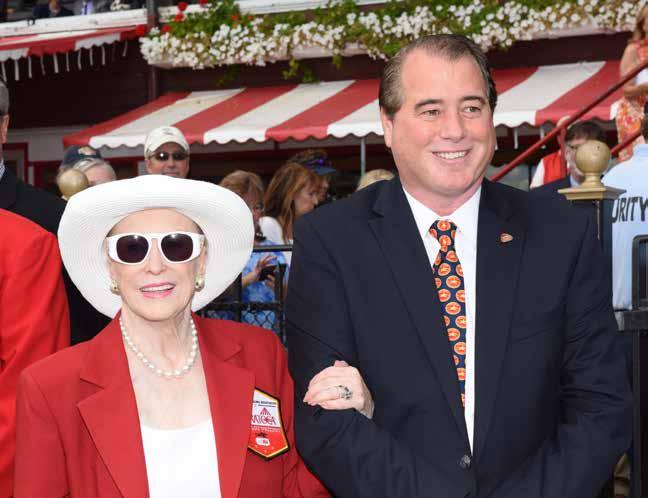
John Hendrickson’s gravestone in Saratoga is inscribed thus: “A candle loses nothing by lighting another candle.”
A truer tribute never has been penned about any soul, for John was a man who gave of himself, generously and without reserve. Before his passing and since then, reams have been written about his achievements; his work on behalf of the people and horses in our Sport and his storied romance with his late wife, the elegant Marylou Whitney.
When he passed from this Earth on August 19, 2024, he left a legacy all his own: a man who loved Life, his wife, horses and everyone who entered his circle.
John and Mrs. Whitney loved each other, they loved the world, and they gave literally millions to causes that touched their hearts.
Those are the public things, recorded in horse racing and general media. Third-person stories, usually by journalists who’d observed but didn’t know either of them intimately.
It’s taken 10 months for me to collect my thoughts; I’m grateful to have this opportunity to share with Equicurean readers this year. (I didn’t have the emotional wherewithal for a long time, to express my feelings and share my grief over losing such a dear soul.) There’s so much that race fans should know about John, so many stories: like the Five Blind Men and the Elephant, I’ll attempt to draw a picture for you, so you might see him more-fully than racing media alone can tell. (I could write a book about John; his Life and our Friendship – so many layers, so much to tell.)
Mrs. Whitney had been in the Saratoga spotlight since 1958, when she married C.V. (Sonny) Whitney. John’s light began to shine in Saratoga in 1994, when he and Mrs. Whitney began dating. (Mrs. Whitney was happy to share her spotlight; their individual philanthropic projects merged into one, thereby exponentially growing their beneficence.)
I met John on the phone on March 1, 2000. I remember that date because it was the day before my birthday, and I was on my first day at my new job at Borders. I’d been hired to be the Community Relations (PR) Manager of the new Borders store in Saratoga – but it was still being built on Broadway. I had a makeshift desk in the backroom of the Colonie Borders, thankfully close to the coffee and the Break Room. I hadn’t been at work more than an hour when the phone rang on another desk. Someone answered, and handed it to me: “A John Hendrickson wants to talk to you…?”
Wait – what? Stunned, I sputtered “Hello,” or something equally witty. John asked if I’d do him a favor: John had commissioned a coffeetable book, written by Jeffrey Rodengen: The Legend of Cornelius Vanderbilt Whitney. John and Mrs. Whitney secured 5,000 copies, and wanted to sell them to raise money to build a Cardiac Catheteization lab at Saratoga Hospital.
The favor: John asked if we could host a book-signing at my Borders store. Without consulting with the store manager, or the regional VP, I yelped, “YES!” and a date was set.

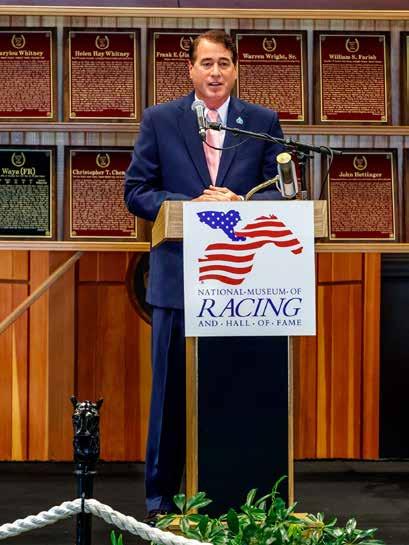
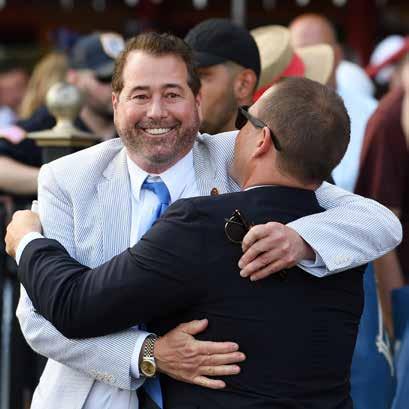
Over the course of the next three months we worked closely, and created a memorable experience, and raised quite a bit of cash for the Hospital. A Friendship was forged.
Shortly thereafter, I ran into John and Mrs. Whitney in town, then at the track. Both times –every time – he rushed up to me, hugged and kissed me on the cheek. Every time someone asked one of us how we knew each other, he always responded,
“She did a big favor for us…”
I started receiving hand-delivered invitations to parties, and made it onto their list to get their gigantic, crazy Christmas cards. Somehow, just doing my job, I’d been blessed to earn the favor of the King and Queen of Saratoga.
I received many emails over the years from John, confidences about projects he planned for the Racing Museum and Hall of Fame, and thoughts about the direction in which the Sport was moving – things he wasn’t ready to reveal to others.
In turn, I confided in him, and was grateful for his attentive ear, and heart. He’d become like the baby Brother I’d never had.
I had Covid for 42 days at the beginning of the Pandemic, in 2020. John sent an urgent email: he’d heard I was sick, did I need anything, please take Remdesivir. He assured me that he was praying for me, and would continue until I told him that I was out of the woods. He called several times during my battle with the virus.
John F. Hendrickson was born in Alaska, and died in Saratoga. A man of great faith and profound love for his friends, family, employees – he gave to everyone who came across his path, I am sure. Generosity-of-heart comes directly from God, and John knew God so well. How else could he have -- and sustain -- such energy; balance so many projects and make – and keep commitments with such grace?
Grace, like Generosity, is an attribute of the Divine. John is with God and his treasured Marylou. Both are healed, both are whole and beautiful again –and both will be sorely missed this first Summer in Saratoga, when John won’t (physically) be in the Clubhouse; in the Backstretch; at the Clinic he built for the workers. But his fingerprints, like those of his darling, are all over the city, the track, the region.
The – (dash) between those dates on his stone is more than just a punctuation mark. It stands for so much. In-between those two dates was a Life of one who lived full-out, with great passion and verve. Thank you, John, for the memories, and for your gift of Friendship.
Thank You, God, for John.
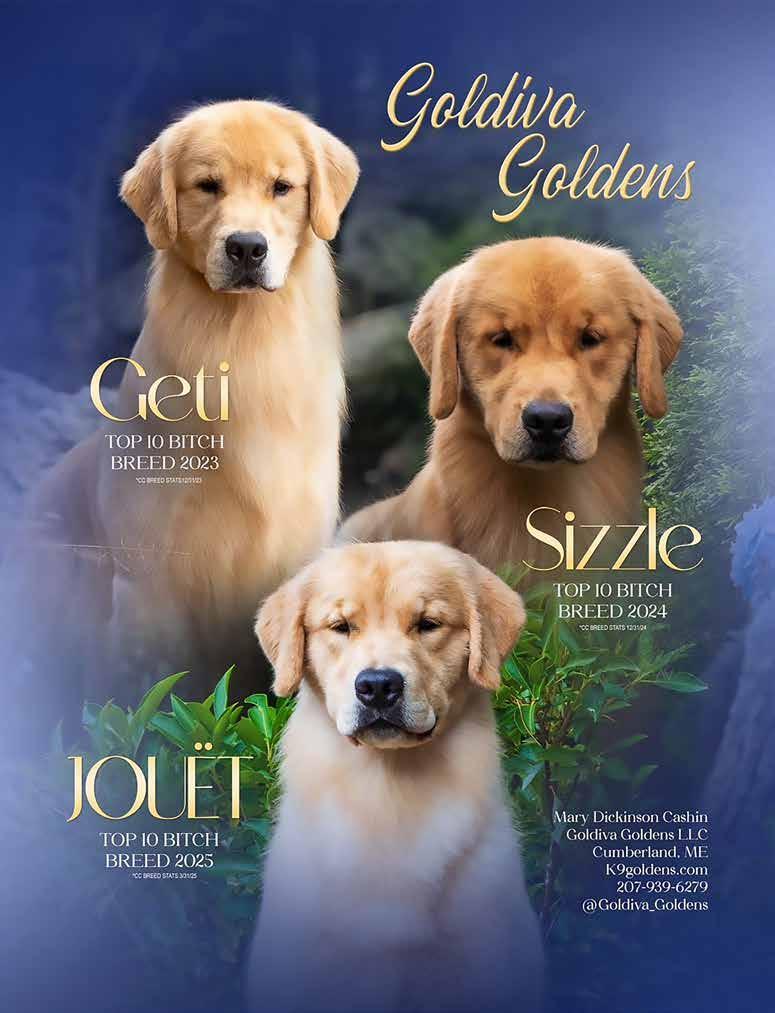
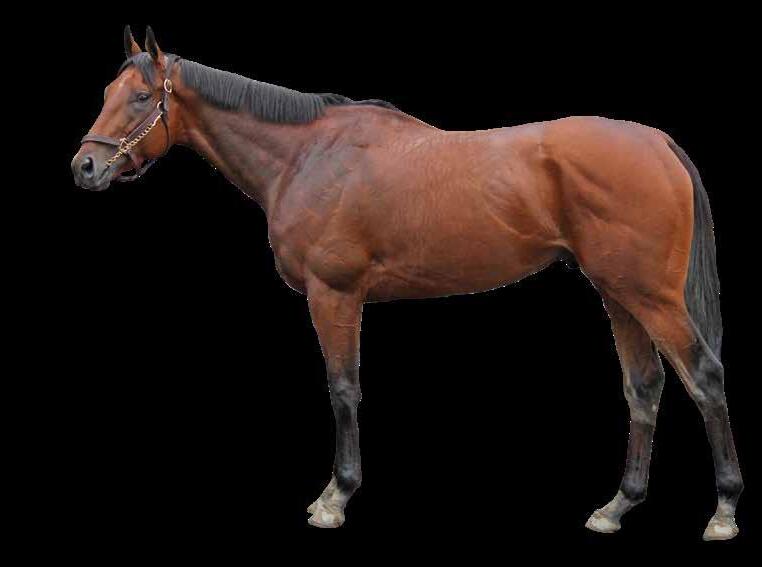
When buyers of Thoroughbreds consider a horse for purchase, one of the key considerations is conformation. Conformation is the way a horse is physically put together. The bones, muscles and proportions of the animal are the characteristics that ultimately prepare them for their job—that of running quickly with great efficiency. Human beauty is relative—every culture and every individual has standards of beauty that may not jive with those of anyone else. Everyone is beautiful to somebody.
This is not the case in the equine world: each breed has standards of beauty. That beauty is not superficial, but rather tied directly at the unconscious level to expectations for the jobs of horses within said breed. Draft horses work hard for a living: they are stocky and muscular, with thick legs and strong backs. Thoroughbreds must be able to run fast, with grace, for grace of movement actually is a factor in the science of winning races.
Long, elegant strides are the domain of those who win purses, while jackrabbit runners are far-less likely to take the day. This is a most egalitarian concept: a Thoroughbred doesn’t win a race because s/ he is liked better by the stewards or race announcer. No one votes on who should win — or the Triple Crown would be achieved every year. A Thoroughbred must cross the finish line first to win a race.

| AUGUST 4 & 5
Experience the excitement, tradition, and prestige of “The Spa!”
Held during the prestigious Saratoga race meet for 100 years, Saratoga selected yearlings regularly go on to become racing’s next superstars.
The Saratoga Sale experience is one of the most unique in the Thoroughbred world, offering a rich racing and social scene.
Yearlings catalogued in The Saratoga Sale have been selected on pedigree and physical conformation by Fasig-Tipton’s respected inspection team. The quality on offer is reflected in the sale's recent results, including last year's sale, which shattered records for gross, average, and median.
Recent graduates include Breeders' Cup Classic winner Sierra Leone, backto-back Preakness S. winners National Treasure and Seize the Grey, and Grade 1 winners And One More Time, Kingsbarns, and Prince of Monaco.
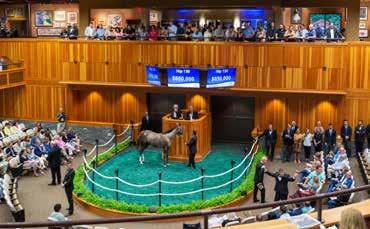
AUGUST 10 & 11
Held the Sunday and Monday following The Saratoga Sale, the New York Bred Yearlings sale is the industry’s leading source of quality New York-bred yearlings.
The New York Bred Yearlings sale showcases New York’s finest yearlings. The sale is the industry’s leading source for quality New York-bred yearlings eligible for the $65 million distributed each year in purse money, incentives, and awards for New York-breds.
Recent graduates include Grade 1 winner Therapist, graded stakes winner Mo Plex, and New York-bred champions The Wine Steward, Cara's Time, Dr Ardito, and Silver Skillet.
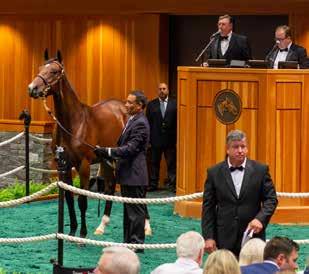

WRITTEN & PHOTOGRAPHED BY
L.A. BERRY
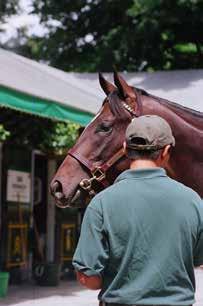

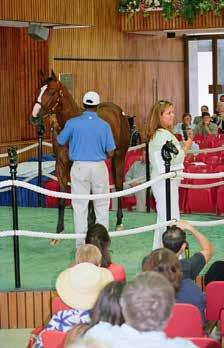
“However, for a dazzling display of white shirt fronts; top hats, low-cut gowns and diamonds, the like of which you will not see even at the opera, you must attend the yearling auctions. Every night, except Saturday and Sunday of the two middle weeks, just after dinner, the show is on. Here the sportsmen and women turn out en masse to match their wits against the shrewdest judges of horseflesh in the land, paying four or five hundred thousand for as unpredictable merchandise as can be imagined. Time and again the $1,500 yearling turns out to be a champ while the $25,000 one turns out a dud; and all the judgment and experience in the world doesn’t prevent you from making a mistake. “This is unquestionably the leading horse mart in the country, doing as much as five times the volume of all others. Its moving spirit is E.J. Tranter, who operates under the name of Fasig-Tipton Company, handling ninety per cent of all U.S. thoroughbreds sold at auction. Congregated here are yearlings of the finest bloodlines, the leading American stables holding out their most promising stock for just this opportunity to put them under the hammer…”
It has been a century since Turf & Sport Digest painted that editorial portrait of Saratoga’s August horse sales. While much has changed – top hats and low-cut gowns have been replaced by khaki and linen – a spectacular parade of prospects continue in strut their stuff front of the gavel and under the timeless name of… Fasig-Tipton.
Enoch James “E.J.” Tranter became a Fasig-Tipton partner after (depending on your historic account) the passing on November 5, 1902, of 81 year-old William B. Fasig, four years after Fasig and Edward A. Tipton co-founded an annual horse auction at Madison Square Garden known as “Old Glory.”
Or, it may have been after the Old Glory sale of 1907, when Turf, Field and Farm reported how an economic downturn and bank closures threatened the sustainability of the “Grand Aggregation of Thoroughbred Stallions, Mares, Racehorses, Yearlings and Weanlings” and the reins were handed over.
Either way, the result became Tranter transforming the art of auctioning horses.
By the mid-1900’s Time magazine noted Fasig-Tipton had corralled the racehorse market when it signed an agreement with most of the nation’s leading breeders, giving it sole rights to sell their horses. In return, Fasig-Tipton built stalls, sales paddocks and other installations at Saratoga, making yearling sales there the most famed in the land.
By the close of 1929, the New York Times called Tranter, “The man who knows how to turn the tide of a sale.”
In his 1974 book, Fair Exchange, Humphrey S. Finney outlined how Tranter turned horse sales from a sprinter into a distance goer, by brokering deals with banks that allowed the young company to weather some financial instability and then, through dramatic changes to the sales catalogue format.
Originally, the pages for each sale horse might list up to 30 generations of pedigree, with limited or no produce record, and subjective descriptions written by consignors. Tranter redirected their emphasis to the performance and production histories of a horse’s closest relations, limiting a page to three or four dams, with detailed information about each mare’s performance. He insisted on health certificates for all horses entered in his sales, and pregnancy certificates for broodmares offered in foal, making Fasig-Tipton the first horse sales company ever to do this.
Today’s Fasig-Tipton Sales continue that tradition of select yearlings with the Saratoga Sale (seen as the start of the North American summer sale season), as well as preferred yearlings (New York Bred Sale), and horses of all ages (Saratoga Fall Mixed).
Two nights of Select Sales spotlight the nation’s top yearlings. During these sessions, one may only sit inside the pavilion if a reservation has been made in advance. But the public is otherwise welcome on the grounds and inside the pavilion to appreciate both the horses in front of the gavel and on the walls, interpreted through art presented by the Cross Gate Gallery of Lexington, Kentucky.
The Saratoga Sale has produced some great names in racing, including 2003 champion (New York-bred) three year-old colt Funnycide, 1994 champion mare Sky Beauty and Kentucky Derby winner Go For Gin, 1993 Belmont Stakes winner Colonial Affair, and the historic Hoist The Flag, Danzig, Conquistador Cielo, and Open Mind.
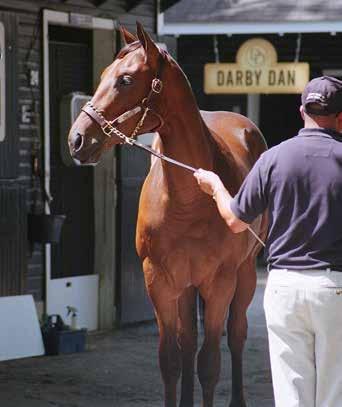
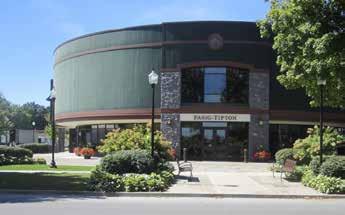
The Pavilion at Saratoga that hosts the FasigTipton Saratoga Sales is named for Humphrey S. Finney, but who is the man behind the name? Finney was born in Manchester, England and came to New York as a teenager in 1921 where it didn’t take long to find horses. He showed drafts in Michigan, groomed polo ponies in Ohio and procured horses for the Coast Guard during WWII before becoming a horse auctioneer.
In 1947, he was sale manager overseeing a Hollywood lot of Thoroughbreds from mogul Louis B. Mayer’s stable. As the sale began, L.B. joked, “I found Clark Gable as an extra and converted him into the biggest thing in pictures. Now I’m going to convert Finney into the biggest salesman in the horse business.”
As announcer, Finney’s Hollywood-style showmanship set prices soaring and Mayer’s string sold for $4.5M, the largest sum ever collected for the Fasig-Tipton Company.
Don’t worry. You (probably) won’t buy a horse because you inadvertently scratched your nose at a Fasig-Tipton Saratoga sale. To bid on a horse, you first have to register as a buyer on FasigTipton.com, where you can create an account and, after financially qualifying, be approved to bid.
After that, it’s just a couple of heady, hope-filled steps:
Get a sale catalog. Review the horses offered (hip number, consignor, current price) and their breeding. If possible (psst, it’s one of the best parts) go out to the barns surrounding the pavilion to inspect the horses and see how they move and behave in-hand. Some sales may allow you to place advance bids online prior to the actual sale.
Tip: before the bidding fun begins, be sure to review the Terms and Conditions of the Sale.
On the day of the sale, you can bid online via the console on the Fasig-Tipton website but what fun is that? You’re in Saratoga! Yes, you can attend in person (make a reservation in advance), get assigned a bidder number and bid old school, live auction, raise-a-paddle style.
If you’re the successful bidder, a Fasig-Tipton rep will contact you to complete an Acknowledgement of Purchase and finalize the transaction.
It’s up to you to arrange payment and transfer of the horse. Congratulations! You’ve bought into racing’s future.
In March 2022, in response to the evolving landscape of Thoroughbred sales, Fasig-Tipton launched a secure, convenient way to offer horses to the public anywhere in the world via an online auction platform, Fasig-Tipton Digital, (digital.fasigtipton.com).
Ready to dabble in the dream? As auctioneers are wont to say, “Don’t stop to think now! We left common sense behind a long time ago.”
2025 Fasig-Tipton Saratoga: Saratoga Sale, Selected Yearlings (August 4-5); New York Bred Yearlings (August 10-11); Saratoga Fall Mixed (October 14), fasigtipton.com.
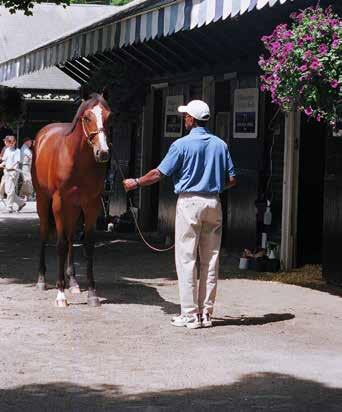
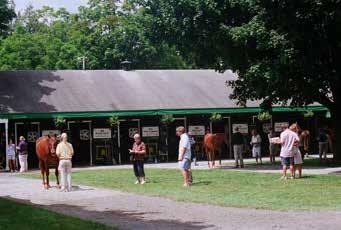
The 2024 103rd Saratoga Sale set set records for gross, average and median, and posted the lowest RNA rate since 2015.
Speedway Stables secured hip #183, an Into Mischief x Sweet Sting/Awesome Again colt bred in Kentucky by Pam and Martin Wygod, for $2.4M. The highest-priced yearling was a $3.4M Not This Time colt; a dozen yearlings sold for a million or more. 154 yearlings sold for a record gross of $82,160,000, up 9.5% from 2023, when the same number of yearlings sold for $75,055,000.
“We almost went back-to-back with milliondollar horses with the first two through the ring,” said Fasig-Tipton president, Boyd Browning. “We felt very confident coming here that the quality of horses [was] the best we ever had. I think the buyers proved us right.”



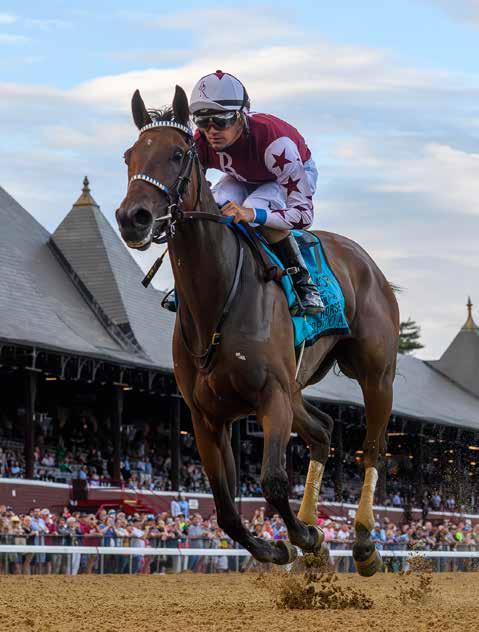


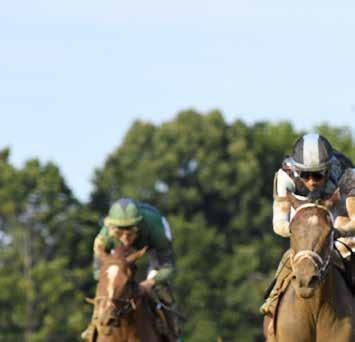
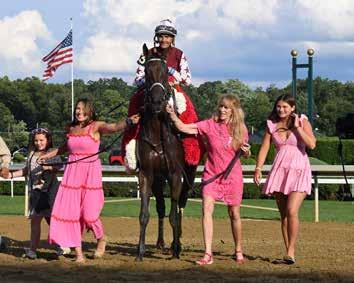
WRITTEN BY L.A. BERRY
In 2022, she was just Hip 20 at the Fasig-Tipton Kentucky October Yearling Sale, selling for an honest but unremarkable $40,000 in comparison to the Gun Runner daughter striking the gavel for Claiborne Farm at $700,000.
But that was before 10 wins, $4.8 million in earnings, and two Eclipse Awards, for Horse of the Year and Champion Three-Year-Old Filly.
Meet the racehorse they call The Grizzly: Thorpedo Anna.
Thorpedo Anna (Fast Anna x Sataves) is the kind of filly that supports why Bloodhorse.com calls her grandsire, Medaglia d’Oro, the leading active North American sire by global Stakes winners; the distaff relations thrown on her sire line include 2009 Eclipse Award Horse of the Year, Rachel Alexandra, and two-time Eclipse Award winner, Songbird.
From her dam, Sataves, she has inherited the power of 1977 Triple Crown champion, Seattle Slew, and the early bloom of her grandsire, Uncle Mo (x Indian Charlie), named American Champion Two-Year-Old in 2010 for his unblemished start and like him, she broke her two-year-old maiden on a win, crossing the wire first at Keeneland and a few weeks later, at Churchill Downs.
Under the good and consistent hands of the only jockey she has ever known, Brian Hernandez, Jr., winning has been a habit ever since.
The Lafayette, Louisiana jockey has ridden Thorpedo Anna on all 10 trips to the winner’s circle out of 13 starts, including the 2024 G1 Kentucky Oaks and G1 Breeders’ Cup Distaff.
“She’s that once in a lifetime racehorse,” he told Thoroughbred Daily News on May 1, 2025, after confirming he would throw his leg over for another season. The Eclipse Award-winning jockey has earned 2,500 career wins since he began riding racehorses in 2003.
“She just goes out there and does what she needs to and puts them away. She goes out there and shows her dominance is the best way to put it.”
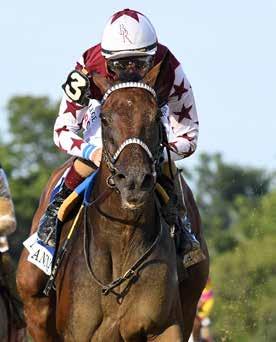
Racing has its own vernacular and its seasoned veterans have always had a knack for understatement when it comes to working with young horses. An airborne colt on the end of a lead rope might earn a droll, “Nice kite ya got there.”
And despite the loftiest of intentions, some horses make their own name.
Thorpedo Anna races for the partnership of Nader Alaali’s Brookdale Racing, Mark Edwards, breeder Judy Hicks and the McPeek family’s Magdalena Racing. Her Jockey Club-registered name reflects its athletic aspirations: Edwards’ granddaughter, Anna Thorp, is a swimmer whose competitive nickname, ‘Thorpedo Anna’ is a nod to five-time Australian Olympic swimming gold medalist, Ian ‘Torpedo’ Thorpe.
But for her trainer, Kenny McPeek, Thorpedo Anna has never been one to tread water. Referring to the filly’s raw power and ready appetite to be first in her class, even before her 1:50:83 win in the 2024 Kentucky Oaks over a sloppy track he said, “They better bring a bear because I’m bringing a grizzly.”
Just ask exercise rider, Danny Ramsey. Last Christmas, the 75 year-old Bahamian native -- who has breezed three Kentucky Derby winners (Fusaichi Pegasus, Monarchos, Mystik Dan) – told the Paulick Report that Thorpedo Anna was the “toughest filly I’ve ever ridden.”
“I’ve been on a lot of good fillies, but she’s the best. What makes her different is when I’m riding Thorpedo Anna I cannot hear her hitting the ground. That’s how light she is on her feet. She just floats over the track. She really does.
“She’s like no one else. But she’s tough. She’s very aggressive on the track. You’ve got to hang on tight.”
The trick to riding her, oh grasshopper, is to stop her before you can’t stop her.
“Before she gets aggressive,” he advises. “That’s how I gallop her. The minute she
tries to run off with me, I stop her before she gets aggressive. Then, she’ll try me again! Sometimes she’ll say, ‘I’m going to fight you.’ The more she fights, the more I say, ‘You ain’t goin’ nowhere. You stay right here.’”
She is not, in horsemen’s parlance, a horse to ride ‘on the buckle.’ Meaning, on long and loose reins (that buckle on their end).
Fuggedaboudit, he says. “You can’t do that with her. You’ve got to hang on tight. I’ve got to eat my Wheaties before I get on Thorpedo Anna in the morning.”

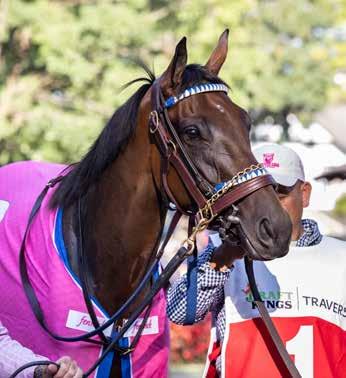
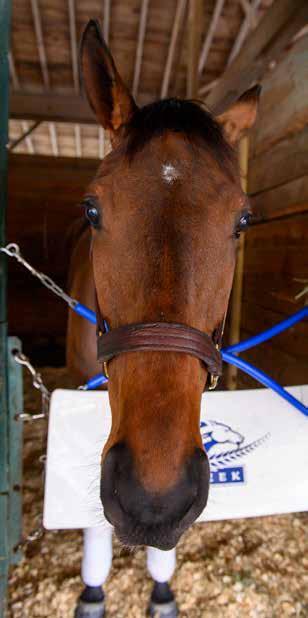
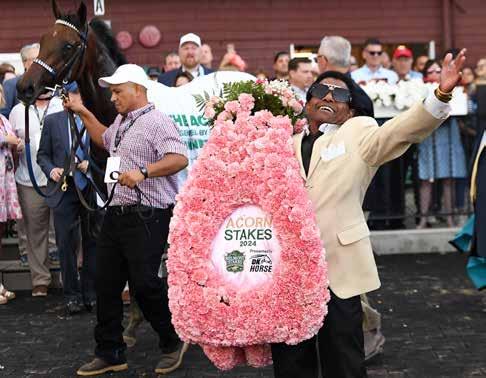
Fortunately, Saratoga fans of the reigning Horse of the Year can take in morning workouts, without the cereal, at the Oklahoma Track and Whitney Viewing Stand, where the days start early but the glimpses of greatness are good.
And if you’re lucky, you may catch a few mellifluous notes of Ramsey singing while riding by. He’s said to like a good gallop to Journey’s Don’t Stop Believing or Queen’s We Are The Champions.
Last summer, Thorpedo Anna won hearts at Saratoga Race Course with a 5 1/-2 length romp in the June 7 DK Horse Acorn Stakes, and on July 20, she turned a dead-last break from the gate into a 4 1/2-length win in the Coaching Club American Oaks.
The Graveyard of Champions however had wagged its finger and, in the $1.25 million Draftkings Travers, pointed it at the 1 1/4-mile homestretch where, after an epic neck-and-neck battle worthy of a Walter Farley story, Thorpedo Anna placed by a head to Fierceness.
But The Grizzly took a crunch out of the Travers boys club, out-running both the Belmont and Haskell Stakes winner, Dornoch, and Breeders’ Cup Classic champion, Sierra Leone.
Thorpedo Anna started her 2025 racing season with consecutive wins in March and April at Oaklawn Park but on May 2, returning to Churchill Downs where her winning career had begun, she had an uncharacteristic last-place finish after experiencing interference in the first turn of the G1 Fasig-Tipton La Troienne Stakes.
“At this point, she has a clean bill of health,” her trainer reports. She passed examination by Dr. Larry Bramlage at Rood & Riddle Equine Hospital in Lexington, Kentucky. An internationally recognized equine orthopedic surgeon, Dr. Bramlage has been the on-call veterinarian for the AAEP (American Association of Equine Practitioners) at the Kentucky Derby, and a media consultant during the Triple Crown and Breeders’ Cup.
It’s a gentle reminder that even the most ferocious of fillies can be fragile, too.
“They call her The Grizzly,” says Ramsey. “But I don’t call her that. I call her My Girl. I told my wife, ‘I’ve got another girl in my life, okay?’ She said it’s okay.”
Saratoga says it’s okay, too.
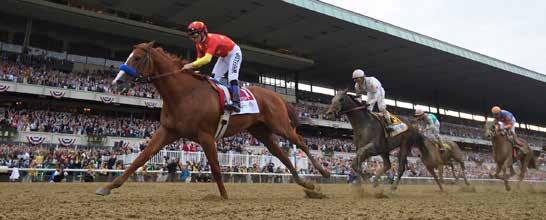
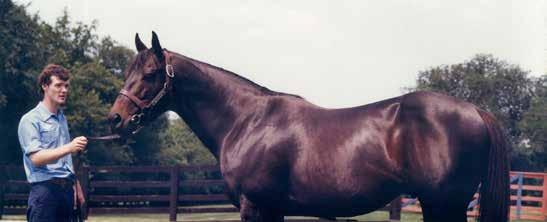

WRITTEN BY L.A. BERRY
Following the history of Thoroughbred racing’s Triple Crown is like dancing the Vienna Waltz: One step forward, one back, and then a couple to the side.
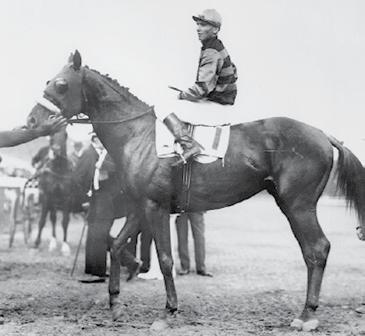
-
Only 13 horses have won the right to be called a Triple Crown champion:
Sir Barton (1919) Gallant Fox 1930)
Omaha (1935)
War Admiral (1937)
Whirlaway (1941)
Count Fleet (1943) Assault (1946) Citation (1948) Secretariat (1973)
Seattle Slew (1977) Affirmed (1978)
American Pharoah (2015) Justify (2018)
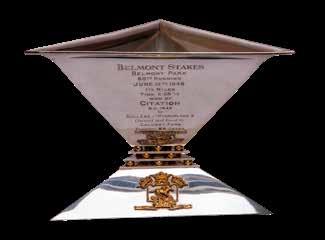
Because each of the three races composing its jewels – the Kentucky Derby, Preakness, and Belmont Stakes – existed well before a longtime Daily Racing Form columnist and writer for the American Racing Manual from Long Island named Charles Hatton backed into dubbing the series the “Triple Crown” in 1930.
Hatton, according to a March 16, 1975 New York Times obituary, was covering the Kentucky Jockey Club Stakes for The Running Horse, a racing paper that merged into The Daily Racing Form and Morning Telegraph when he chose the phrase to describe Gallant Fox’s run through the three big races for three year-old Thoroughbreds.
But, the NYT printed, “It was Secretariat, the 1973 Triple Crown winner, who made the phrase widely heard, and it was the horse that displaced Man O’ War in Hatton’s view as the greatest horse he had ever seen.”
But it wasn’t his first inspiration. “When Charles Hatton began calling Gallant Fox’s 1930 run the ‘Triple Crown,’ he was mining a term said to have originated in mid-19th century England when a racehorse named West Australia won the 2000 Guineas, the Derby, and the St. Leger,” observed Marcus Hersh for the Daily Racing Form in June 2012.
Citation's Triple Crown trophy awarded retroactively to his connections in 1957. Credit: The Kentucky Derby Museum Permanent Collection.
The three American races existed before the series, with the Belmont Stakes first to run in 1867, the Preakness in 1873, and the first Kentucky Derby in 1875.
In 1912, Kentucky senator Johnson N. Camden Jr. proposed a Triple Crown of regional races at alliterative Lexington, Louisville and Latonia locations, and later suggested a Quadruple Stake with the inclusion of Douglas Park. Neither idea materialized but seven years later, a horse called Sir Barton became the first stallion to win all three races. It would not happen again until James E. “Sunny Jim” Fitzsimmons made it look easy for Belair Stud, clinching the crown in 1930 with Gallant Fox and again in 1935 with Omaha (sired by Gallant Fox).
The order of the races has varied. From 1932 through 2019 the Kentucky Derby ran first, followed by the Preakness and Belmont. But before 1931, the Preakness preceded the Derby 11 times, and in 1917 and 1922, the Derby and Preakness ran the same day.
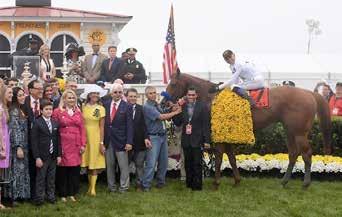
Justify - the most recent Triple Crown winner in the 2018
Head spinning yet? Because the entire series was bumped to June in 1945 during World War II, and in 2020, COVID-19 led to running – for the first time - a foreshortened Belmont Stakes as the opening leg.
Belair Stud and Calumet Farm remain tied for most Triple Crown winners with two each; Calumet has Whirlaway (1941) and Citation (1948) and Whirlaway remains the first and only horse to win – in the same year - the Travers Stakes at Saratoga.
On the distaff side, jockey Julie Krone and trainer Jena Antonucci are the only women to win Triple Crown races. Krone in the 1993 Belmont Stakes on Colonial Affair, and Antonucci in the 2023 Belmont Stakes, with Arcangelo.
But for now at least, the Triple Crown will remain a boys’ club where all 13 winners have been stallions and, as of 2025, American Pharoah and Justify its only surviving dancers of this waltz.
Attempts at a Filly Triple Crown or Triple Tiara, have never captured the same attention. In 1949 and 1952, when fillies clinched the Kentucky Oaks, Black-Eyed Susan Stakes, and Coaching Club American Oaks, no racing press took notice. In 1961, NYRA tried an in-state Triple Tiara that was won, between 1968 and 1993, by eight fillies.
“It’s no wonder the term ‘Triple Crown’ stuck,” says DRF writer Hersh. “Three is the smallest odd prime number and regularly appears in philosophical systems. Racing jurisdictions around the globe have found a way to link a trio of races and call it a Triple Crown.”
ARGENTINA:
Gran Premio Polla de Potrillos y de Potrancas, Gran Premo Jockey Club, Gran Premo Nacional
AUSTRALIA:
• Golden Slipper, Produce Stakes, Champagne Stakes (2 year-olds)
• Randwick Guineas, Rosehill Guineas, Australian Derby (3 year-olds)
CANADA:
Queen’s Plate, Prince of Wales, Breeders’ Stakes
ENGLAND:
2000 Guineas, Epsom Derby, St. Leger
IRELAND:
2000 Guineas, Irish Derby, Irish St. Leger
JAPAN:
Satsuki Sho, Tokyo Yushun, Kikuka Sho

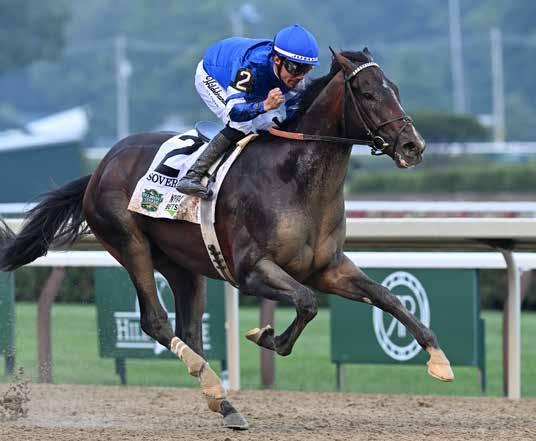
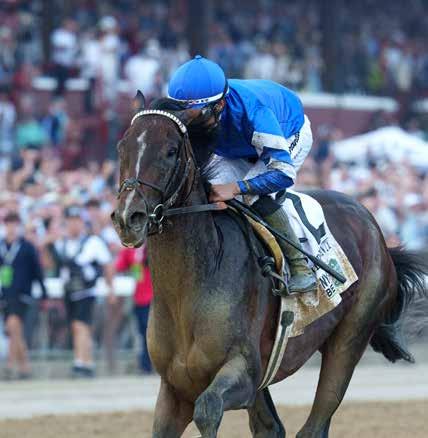
WRITTEN BY L.A. BERRY
“Been around racing 50 years,” Hall of Fame trainer Woody Stephens told Sports Illustrated reporter William Leggett in 1978, “and I’ve seen dawn come up over a lot of tracks. People will tell you about the great races between Citation and Noor in the 1950s, and between Ridan and Jaipur in the Travers at Saratoga in 1962. But Affirmed and Alydar? Whatever it is that these two horses have cannot be bought or manufactured. It’s the greatest act racing has ever had. I hope it never ends.”
In some ways, Stephens got his wish.
Because half a century later, noble horsepower has driven Sovereignty, the great-great-grandcolt of Triple Crown champion Affirmed, to claim his rightful spot on racing’s historic throne, coming 18th out of the gate on 7-1 odds to set a 104 Beyer personal best and win the 2025 Kentucky Derby by 1½ lengths on a muddy track for jockey Junior Alvarado and trainer Bill Mott, under the royal blue silks of Godolphin.
The blood of champions runs strong in this one and with plenty of pedigree where that came from.
“Sovereignty’s pedigree presents an intriguing blend of speed and stamina influences,” observed KentuckyDerby.com in an overview on the colt shortly after a by-a-neck win in the G2 Fountain of Youth Stakes. “While [leading sire] Into Mischief is often associated with brilliant milers, his ability to sire classic runners is well established. The Bernadini bottom side [Sovereignty’s dam, Crowned, is out of Grade 1 millionaire mare Mushka by Empire Maker] adds a crucial layer of stamina, suggesting the 1¼-mile Derby distance is within reach.”
Affirmed at Spendthrift Farm, 1981. Credit: Wikipedia CCA
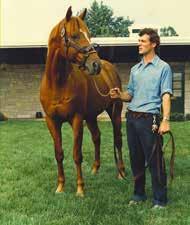
Indeed it was within reach and Sovereignty did his name and forebears proud, winning the 151st running of the race at Churchill Downs in 2:02.31 under sloppy (SY) conditions and returning $17.96 on a $2 bet.
Affirmed is one of three horses from racing’s Triple Crown halcyon days in the 1970s whose bloodlines course through the bay colt’s veins. There are also 1973 Triple Crown winner, Secretariat (through Into Mischief’s grandsire, Stormcat) and 1977 champion, Seattle Slew (Crowned’s great grandsire on her top side).
Jockey Angel Cordero, Jr. called Seattle Slew the best horse by far that he had ever sat on. “He reminded me of Muhammad Ali. He was that good and had that same sort of presence. He’d come into the paddock and you could tell he was showing off.”
Nor was there a shortage of charisma when jockey Ron Turcotte met Sovereignty’s great grandsire, Secretariat. “He was beautiful, a very intelligent horse, and a very nice horse to ride. So for me, it was love at first sight and love at first ride.”
Sovereignty, looking as good on paper as on a track, neatly tied some loose racing ends together for Godolphin. Sheikh Mohammed’s first U.S. classic winner, in the 2006 G1 Preakness Stakes, was Sovereignty’s distaff side grandsire, Bernadini.
“It’s a poignant tribute that his grandson would wear the roses,” observed KentuckyDerby.com, referring to the fulfillment of a Godolphin quest decades in the making, that led to homebred Sovereignty earning Sheikh Mohammed al Maktoum and the racing stable its first-ever G1 Kentucky Derby trophy after more than a dozen attempts.
“You know,” Mott mused, sounding not unlike Stephens from that earlier era, “I’ve been in this game a long time and I’ve dreamed about having my horse go across the finish line first in the Kentucky Derby. And now it’s finally happened and it feels very good.”
For this season, thanks to Sovereignty, satisfaction reigns supreme.
Royal names seem to suit Derby winners. Sovereign, a chestnut colt born April 9, 2016 in Ireland with a white blaze and three white socks, defied 33-1 odds as a Coolmore Stud threeyear-old to win the 2019 Irish Derby.


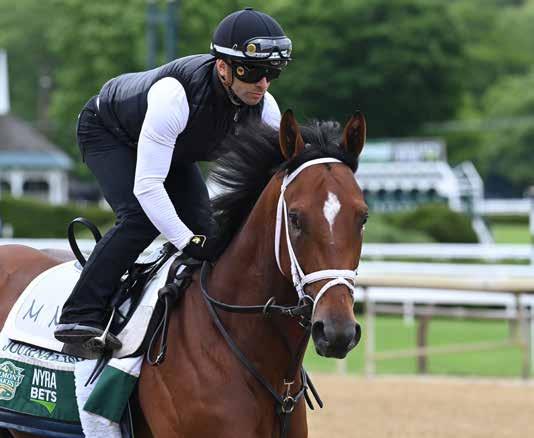
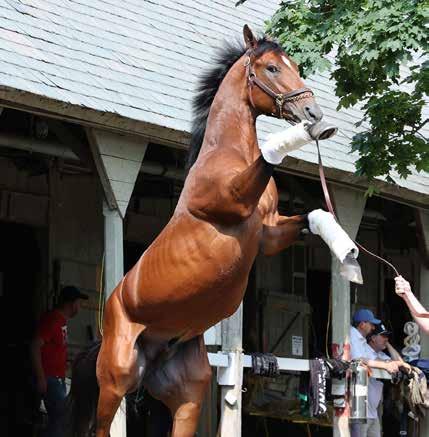
WRITTEN BY WILLIAM G. GOTIMER JR.
Journalism, the immensely-talented three-year-old colt by Curlin, proved best in the Preakness Stakes after his game second place finish in the Kentucky Derby. It wasn’t easy: Journalism had an uncomfortable trip from start-to-finish at Baltimore’s Pimlico racetrack. The betting favorite was off slowly, and bottled up behind the leaders throughout much of the running.
The frustration of being boxed in was obvious by the responses of both Journalism and his rider Umberto Rispoli as they played catch up while looking for a clear path. Once inside the quarter pole, Rispoli chose the ground-saving but treacherous inside path to the leaders, and almost paid dearly for it.
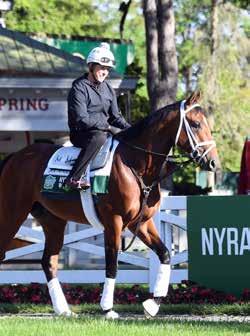
Jockey Flavien Prat on Goal Oriented refused to yield position; Journalism found the hole closed by Goal Oriented and Jose Ortiz, aboard the tiring Clever Again. Meanwhile the leader, Gosger, spurted clear to a four-length lead as Journalism pinballed between his rivals, losing both his momentum and fluid stride. Veteran race-watchers quickly gave up on Journalism, but they’d underestimated his determination: he bulled his way through the traffic, and regained his stride. Having dispatched with the two rivals impeding his path, Journalism set his sights on the leader. Now seeing open space for the first time in the race, Journalism responded with a determined lengthening stride. Rispoli gave Journalism is head, unleashing an outstanding rally and running-down the game pace setter, Gosger, in the final two strides. It was an awe-inspiring performance by a gifted colt over an ultra-game foe. The path chosen by jockey Rispoli –between, rather than around rivals – left some feeling he had risked injury -- but the route paid off for him and Journalism as they snatched the second jewel of the Triple Crown in outstanding fashion.


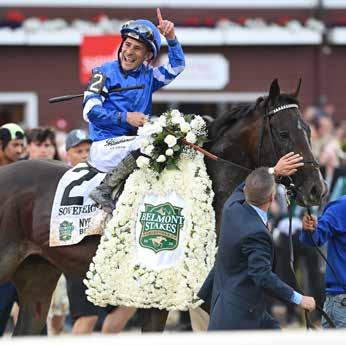
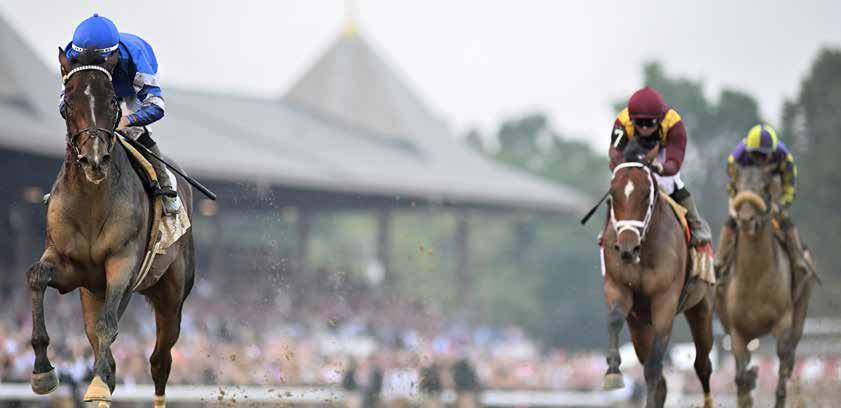
“Courage is being scared to death, but saddling up anyway.”
– JOHN WAYNE
WRITTEN BY WILLIAM G. GOTIMER JR.
The skies opened up on the Friday before Belmont Stakes Day 2025, and dumped 1.5” of water onto the storied track, thereby turning it into a mud-oval.
Miraculously, NYRA’s crack team sealed the track as much as could be hoped in such conditions. By the Belmont Stakes on Saturday evening, it was far-from being dry -- but the horses didn’t sink up to their knees.
As the stellar field of three-year-old colts assembled for this year big race put on a much-appreciated show. It’s rare that a big race -- or any race for that matter – features such a gathering of accomplished Thoroughbreds. Rodriguez, the Bob Baffert-trained Wood Memorial winner and clear early-speed of the race, went to the lead as expected after a clean break. The lightl-raced Crudy with a nice future, accepted the challenge, and forced an honest pace.
The two favorites, winners of the Kentucky Derby and Preakness, respectively, Sovereignty and Journalism, ran next to each other in third and fourth, while Baeza, another inexperienced (but talented) colt tracked behind the leading quartet.
Turning for home, Journalism under jockey Umberto Rispoli made the first move, overtaking the tiring leaders as the appreciative festive Saratoga crowd roared. As Journalism charged to the front, jockey Junior Alvarado aboard Sovereignty angled his mount outside for a clear run at the leading favorite. Ultimately, Sovereignty ran down the game Journalism, who was waging his third hard- fought battle in three weeks. (Journalism raced in all three Triple Crown races, whereas Sovereignty had skipped the Preakness.) Baeza showed once again that the best of his races may be yet to come, ran on well for third.
The screaming crowd confirmed that each of these colts had run their race, in a fairly-run contest. Both Journalism and Sovereignty ran strongly to the wire; the final time was 2:00.69.
Post-race, the connections of both Sovereignty and Journalism showed the class that should be
commonplace, but so often comes up short in bigger events. The riders congratulated each other and each other’s mounts, and the trainers Bill Mott and Mike McCarthy each paid tribute to the other while looking towards the future.
Mike McCarthy will take Journalism back to the West Coast for a needed respite, and stated the Breeders’ Cup Classic was his goal and a chance to meet Sovereignty again at Del Mar in San Diego. The connections of Sovereignty have spoken about the Travers Stakes as a goal. (Surprisingly, a race that Hall of Fame trainer Bill Mott has yet to win.)
2025 has a very deep crop of threeyear-olds; Sovereignty and Journalism are both very talented colts, who show up each time they race. The 2025 Belmont Stakes is what racing was meant to be – a hard-fought, clean race in front of an appreciative crowd. Good job all around.
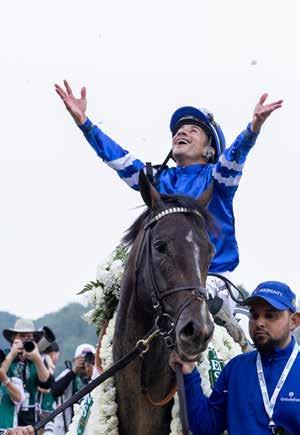

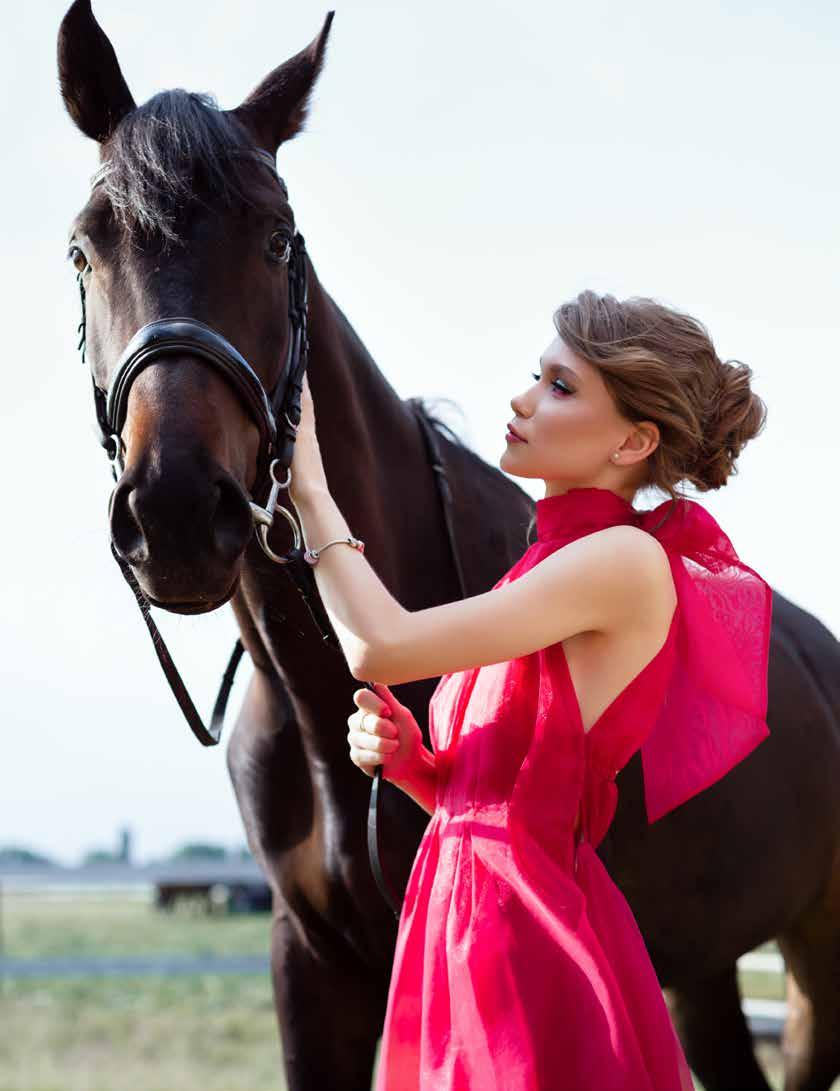






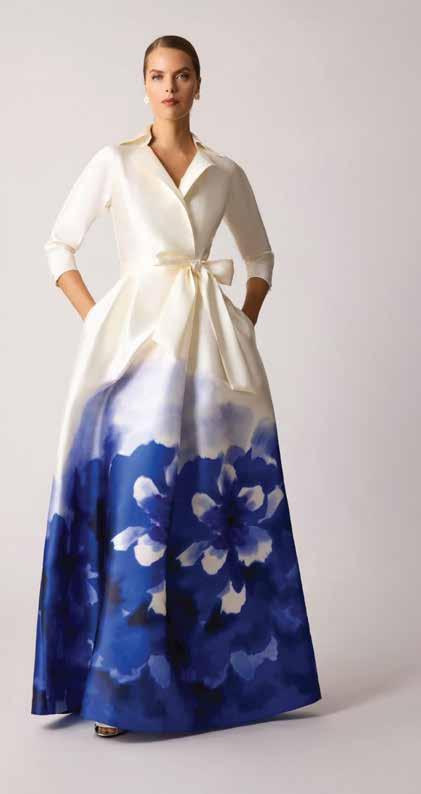
Celebrating 31 years Natalie A. Sillery, Owner









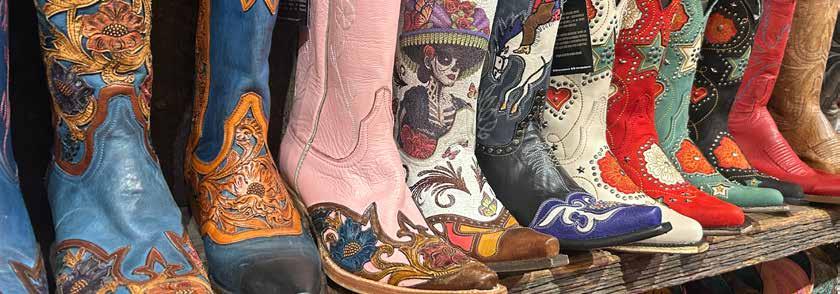
Tourists flock to historic Saratoga Springs for a variety of reason: racing, culture, dining, nightlife, and of course…shopping!
If shopping ranks the top of your list, you owe it to yourself to stop in one of the town’s most unique stores, Saratoga Saddlery. Blending the spirit of the American West with the elegance of the outdoor and equestrian lifestyle, Saratoga Saddlery is the brainchild of owners Sabine and Mick Rodgers.
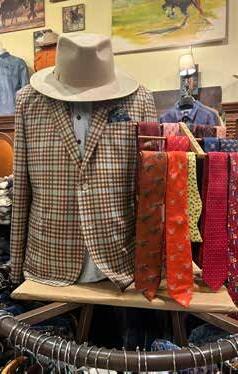
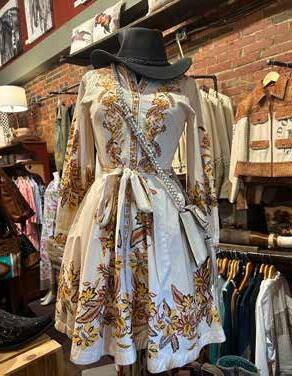
“Personally, I believe everyone should have at least one good pair of cowboy boots in their wardrobe.”
“Our collections at Saratoga Saddlery are rooted in Western-style heritage fashion, but also reflects the refined charm of English Country Style,” said Sabine. “Think Kate Middleton meets the Rocky Mountains.”
Being located smack dab in the center of a horse town, the equestrian world is a big part of Saratoga Saddlery. As an avid polo player herself, Rodgers really connects with the lifestyle that comes with all equestrian sports. “That connection influences what we offer at Saratoga Saddlery, from refined riding-inspired fashion to practical pieces suited for the stables or a day at the races,” Sabine added. “From classic men’s blazers and elegant and fun dresses to cowboy boots and hats, our selection reflects a mix of classic Western Heritage and the elegant English Country Style.”
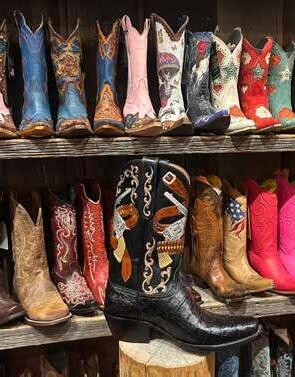
Adding to the unique feel of the store is their custom line, Australian Country Outfitters. Founded by native Australian Mick Rodgers and his father Barry in 1975, Australian Country Outfitters brings a taste of Australia to Saratoga Springs. Offering Leather Hats, Slip-On leather Boots and waterproof wax jackets, the brand “uses the best materials and technology, prioritizing design and functionality,” said Mick Rodgers. “you'll always have a product that stands out.”
Whether you're walking into the store for the first time or shopping online from across the world, you’ll find pieces that are inspired by horses, tradition, and time spent outdoors. Saratoga Saddlery is about more than just clothing; it’s about the equestrian lifestyle.

WRITTEN & PHOTOGRAPHED BY TAYLOR FLYNN
You’ve probably heard of the Triple Crown cocktails—the Mint Julep for the Kentucky Derby, the Black-Eyed Susan for the Preakness Stakes, and the Belmont Jewel for, of course, the Belmont Stakes. A lot of restaurants serve them in the days leading up to and on the famous events, but what about during the rest of the Saratoga Springs track season? I went to two iconic local restaurants to taste what they’re mixing up for a nice evening after the races.


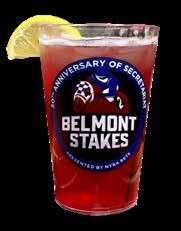
What could be better than sipping one of the most refreshing summer cocktails while watching the sunset over Broadway? Not much that I can think of. Cantina’s 21 and older, drinks-only rooftop is open for the summer, and it is the most picturesque, comfortable, and enjoyable spot downtown. There is a variety of seating including couches, high tops, regular tables, and bar chairs to accommodate groups of any size. If you decide to leave the track early, there are TVs and umbrellas to catch the last few races while shielding yourself from the afternoon sun. I’m sure a margarita is the first drink that comes to mind when you think of this Mexican restaurant, but their mojitos are my personal favorite. Made with Castillo Silver rum, mint, simple syrup, and garnished with a lime, this cocktail is fresh and delicious, especially if you’re not the biggest fan of tequila. If you didn’t think people-watching, listening to music, and chatting with friends could not get any better, try adding a mojito to the equation and thank me later.

• 3/4 cup orange juice
• 2 oz vodka
• Splash of grenadine
• Garnish: Orange slice and a cherry

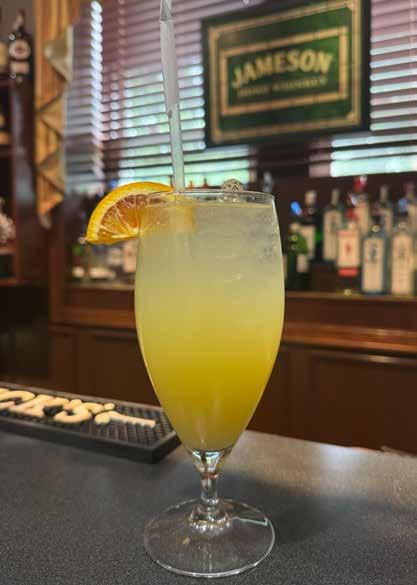
Downtown can get rather crowded and overwhelming during track season, especially on the weekends, and one of my favorite places to venture when I want a more relaxed ambiance is Lake Ridge Restaurant. The cozy bar is in a separate alcove with a TV, and, most importantly, air conditioning. Their menu is phenomenal, and they always have a new rotation of unique and flavorful concoctions. Their latest creation to debut this season is the Tequila Sunshine, a beautiful combination of lemonade, orange juice, Cointreau, tequila, and an orange garnish. Specifically, they use One With Life organic tequila, a local brand that is woman-made in addition to Cointreau. I absolutely love citrus, and this drink has the perfect amount of sweetness. The taste almost reminds me of a creamsicle! This is the perfect pre-dinner refresher after a long, hot day at the track.

No matter what vibe you’re after, Saratoga has a place for it, both in the heart of the city and on the outskirts. With so many restaurants and bars, your new favorite cocktail is just a sip away. Saratoga truly is the summer place to be!




Seabiscuit, jockey George Wool and trainer Tom Smith at Pimlico Nov. 1, 1938.
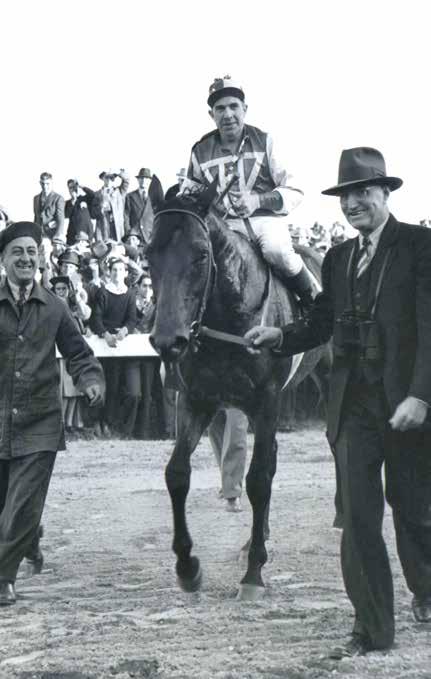

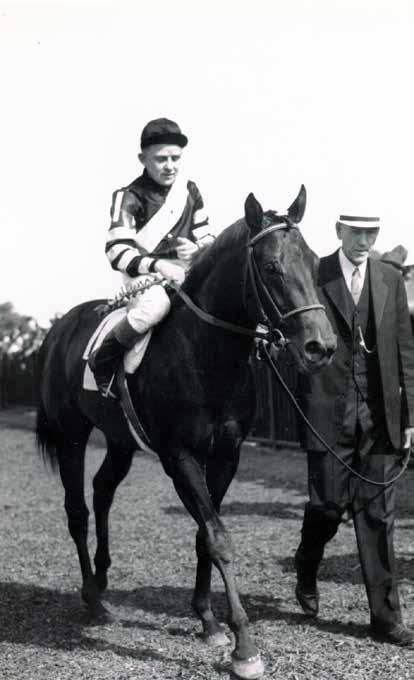
War Admiral, jockey Charles Kurtsinger and trainer George Conway at the 1937 Belmont Stakes. Keeneland Library Morgan Collection
WRITTEN BY BRIEN BOUYEA
Unlike many of thoroughbred racing’s most famous rivalries, the one between Seabiscuit and War Admiral was determined not over the course of several meetings like Affirmed vs. Alydar but in a singular contest for the ages.
On Nov. 1, 1938, the people’s horse, Seabiscuit, met the mighty War Admiral in a match race at Pimlico Race Course in Baltimore in what was being touted as the race of the century. Anticipation for the contest swept the nation. More than 40,000 jammed through the gates at Pimlico and an estimated 40 million more tuned into the radio broadcast. In Nearby Washington, D.C., President Franklin D. Roosevelt halted a cabinet meeting to hear the race call. Seabiscuit and War Admiral both had the legendary Man o’ War in their respective pedigrees, but that was where the similarities ended. Seabiscuit lost his first 17 career races before finding his form in California and becoming a symbol of hope during the Great Depression.
War Admiral, meanwhile, was the standard of what a champion should be − regally bred, fast, powerful, and seemingly unbeatable. His performances in winning the 1937 Triple Crown established him as the best horse in training and one of the best seen in America since his sire. Seabiscuit rose to fame after being purchased by Charles Howard for $8,000. He had previously been a disappointment and was considered lazy. But with new trainer Tom Smith and jockey Red Pollard, he began to win and gain a massive legion of fans. Seabiscuit won 11 races in 1937 and discussion began about what his chances would be against War Admiral, who earned Horse of the Year honors that year.
Howard pressured War Admiral’s owner, Sam Riddle, in the media to arrange a showdown between the two stars. After months of starts and stops in negotiations, terms were agreed upon for the Pimlico Special. A key member of the Seabiscuit team, however, was unable to participate in the race, as Pollard was out with injuries suffered earlier in the year. Howard and Smith turned to a most capable substitute in George “Iceman” Woolf, a future Hall of Famer, to pilot Seabiscuit vs. War Admiral. Pimlico’s owner, Alfred Vanderbilt, feared his track would struggle with handling the massive crowd that was anticipated, so he scheduled the race on a Tuesday, figuring the traditional work day could have keep the crowd manageable. The track could comfortably handle 15,000 in that era, but more than 40,000 showed up for a spectacle that had captivated the nation. Vanderbilt opened up the infield in an effort to mitigate the crowd’s density.
It was Seabiscuit’s day.
“A little horse with the heart of a lion and the flying feet of a gazelle yesterday proved his place as the gamest thoroughbred that ever faced over an American track,” wrote Grantland Rice. “In one of the greatest match races ever run in the ancient history of the turf, the valiant Seabiscuit not only conquered the great War Admiral but, beyond this, he ran the beaten son of Man o’ War into the dirt and dust of Pimlico … the drama and the melodrama of this match race, held before a record crowd keyed to the highest tension I have seen in sport, set an all-time mark.”
Seabiscuit, a heavy underdog, upset War Admiral by getting off to a surprisingly fast start, a change of his usual race tactics, and wound up winning by four lengths in 1:56 3/5, breaking the track record in one of the most famous sporting events in American history.
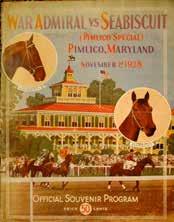


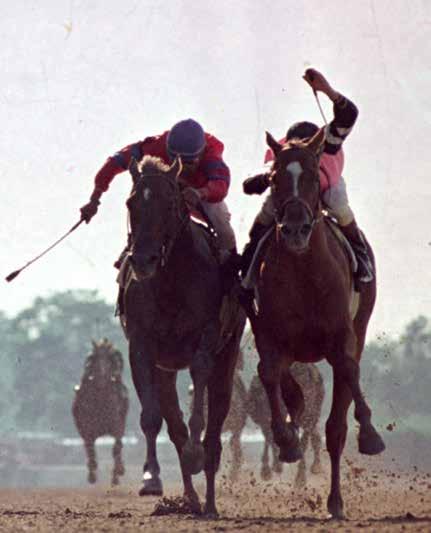


There is a simple test to determine whether something is truly a rivalry - you mention one of the rivals, and immediately most people invoke the other rival’s name. In Thoroughbred racing rivalries, among the best-known is Affirmed vs. Alydar. One can never say, “Affirmed” without someone within earshot replying, “Alydar.” Such was their rivalry that in their two- and three-year-old seasons of 1977 and 1978, respectively, they met 10 times. Each of those 10 times, one or the other won the race.
WRITTEN
BY
WILLIAM G. GOTIMER JR.
Affirmed and Alydar finished first and second in nine of those ten meetings. Each of those finishes were close. Each of the victories were hard-fought.
Each had their own rabid and undeterred fans. They had little in common, coming from different backgrounds - one modestly-bred in Florida, the other royally-bred from Kentucky.
In their 10 meetings on the track, Affirmed got to the wire first eight times, losing once: the Travers Stakes at Saratoga, via a controversial disqualification. It isn’t often that rivalries appear so lopsided on the tally sheet, but so epic were their battles, that Alydar was never considered a longshot in any meeting.
They met six times as two-year-olds; as three-year-olds, they met in the Kentucky Derby, the Preakness, the Belmont and the Travers. In an era prior to the Breeders’ Cup World Championship, there were no more-prestigious three-yearold races than those. Notably, they met on five different race tracks, and at different distances. Each time Affirmed was the leader and Alydar the pursuer. Each time it appeared that Alydar would best Affirmed, but he only did so twice. Such was the expectation, that Alydar would pass Affirmed in the stretch -- that the announcer at the Belmont announced, “Alydar has put a head in front.” He did not. Affirmed, a son of Exclusive Native showed tremendous determination, thus capturing the 1978 Triple Crown. Affirmed’s phenom rider, Steve Cauthen, could not use his usual right-handed whipping motion in the Belmont, and was forced to go left-handed for the first time. A tiring Affirmed responded with grit: the crowd of 65,000+ crowd at shook the very foundations of the grandstand with excitement.
Perhaps the most disappointing for Affirmed fans was the rivals’ last race: the 1978 Travers. It produced only a small field of four horses -- but as is often the case with small fields, trouble ensued. Laffit Pincay, Jr., subbing on Affirmed for an injured Steve Cauthen, moved his mount past a tiring pacesetter named, Shake Shake Shake, ridden by Angel Cordero, Jr. As he did, he dropped to the rail at the same time that Alydar’s rider, Jorge Velasquez, was moving his mount up along the same vacated rail position. Affirmed impeded Alydar, who checked sharply then recovered nicely to run on for second. The racing stewards reversed the order of finish, meaning that the rivalry was settled in the stewards’ booth, and not on the track.
Another meetup had been expected, but it was not meant to be, as Alydar suffered a minor injury that prevented that last race.
To fully understand the Affirmed/Alydar rivalry, it’s important to note that it was more than just a rivalry between two horses. It was, in reality, a face-off between old-line racing, represented by Calumet Farm and Alydar -- and new-blood racing of Louis Wolfson and his Harbor View Farm. With Florida seeking to gain a foothold in the horse breeding business, and Kentucky striving to hold onto its near-monopoly on well-bred horses -- this was seen as a test of the two programs. Calumet Farm was among the most famous and successful farms in the history of American Thoroughbred racing, but had fallen upon difficult times since its heyday of the 1940s and 1950s.
Alydar represented an opportunity to regain the glory. Trained by young trainer John Veitch, Alydar was named for Prince Ali Salman Aga Khan, a personal friend of Calumet’s owners, Eugene and Lucille Markey. (The Aga Khan was known as Aly Kahn; Lucille Markey always addressed him as, “Aly, Darling.”) The Markeys both were in their 80s, wheelchair-bound and the clear sentimental favorites of many in the racing community.
Affirmed was trained by Laz Barrera, an eventual Hall of Fame trainer, but he had not trained for the old-line farms or owners. Affirmed’s owner, Louis Wolfson, was a champion
of Florida breeding, and seen as a threat to the Kentucky racing establishment. Thus, there was considerable rooting for Alydar, many holding to the belief that he would “win the next one.” Affirmed cemented his greatness by having a tremendous four-year-old year in 1979, but Alydar never regained his brilliance after a minor injury.
Affirmed’s legacy was his apparent resolve that would not allow a rival - even one as talented as Alydar - to pass him in the stretch.
Alydar’s legacy was that he was a great horse, who never stopped trying. It was a grand era in racing.


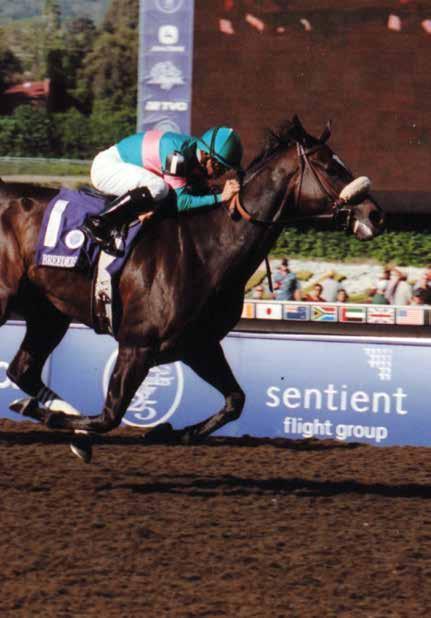

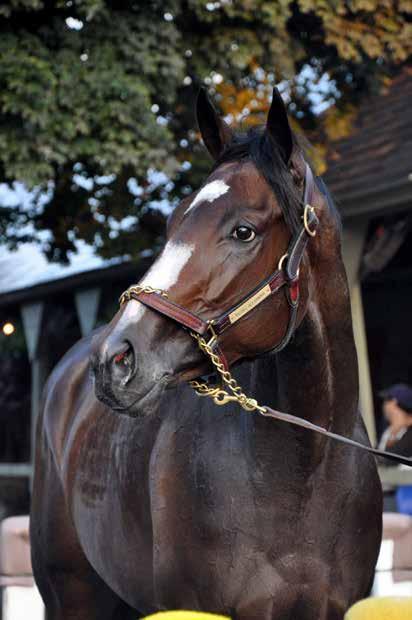
WRITTEN BY L.A. BERRY
Horse racing, like Hollywood, has always loved a good catfight. Among the best rivalry matches of the 21st century would certainly be a good ninefurlong spat on dirt between 2009 Eclipse Award Horse of the Year, Rachel Alexandra, and 2010 Horse of the Year, Zenyatta.
Jockey Calvin ‘Beaux Rail’ Borel, who has never met a crack o’ daylight he didn’t like on an inside rail, rode the 16.2-hand Rachel Alexandra (Medaglia d’Oro x Lotta Kim) to the highest (116) Byers Speed Figure of any racehorse in North America in the 2009 Haskell Stakes, and in the G1 Kentucky Oaks, ignited memories of Secretariat in the Belmont, as they romped to the longest (20 ¼ lengths) win in the race’s history. That set the stage for her transfer to Stonestreet Stables and going up against the colts in the Preakness Stakes, where she became the first filly since Nellie Morse in 1924 to own its homestretch.
Unbeaten in 19 of 20 lifetime starts, Zenyatta (Street Cry x Vertigineux) had a Byers Speed Figure (112) that never really told her full story. She set a speed record (1:40:30) at Santa Anita in the 2008 Lady’s Secret (subsequently renamed the Zenyatta Stakes); had the second-fastest (1:46:85) time ever in the 2008 Breeders’ Cup Lady’s Classic, and fastest closing quarter mile (22.49 seconds) in Del Mar history in the Clement Hirsch Stakes. Growing into a 17.2-hand monster of a racehorse with an estimated 26-foot stride at the gallop (Secretariat’s, comparatively, was just over 24-feet) Zenyatta’s trademark style was stalking her competition from the back before devouring the homestretch and horses in her way like sweet feed in a bucket.
No surprises here that the pedigrees of both share Mr. Prospector (through stallions Street Cry and Roar) and his proclivity as a sire to transmit speed and stamina. The stopwatch finds both mares a more than even match on 1 1/8 miles of dirt. Rachel Alexandra’s best performance at that distance, in the Mother Goose Stakes, clocked in at 1:46:33; Zenyatta set 1:46:85 in the Breeders’ Cup Ladies Classic.
But in this match-up, I think we’d see speed and stamina handled through very different racing styles by very different horses.
Borel said the first time he rode Rachel Alexandra that she told him who really called the shots and, whether as a front-runner or stalking her competition from just off the pace, 13 wins out of 18 starts speaks for itself. In comparison, Zenyatta, whose come-from-behind win in the Ladies Classic was named NTRA Moment of the Year, would have the raw size and power -- and stride -- to back up her ruthlessly stealthy style and ferocious fifth gear in the final stretch.
At their best distance – nine furlongs over dirt – I’d imagine an early pace set by Rachel Alexandra before a push by Zenyatta in the final turn and nose-to-nose battle royale to a photo finish in the final 220-yard furlong.
The rest is up to your imagination.
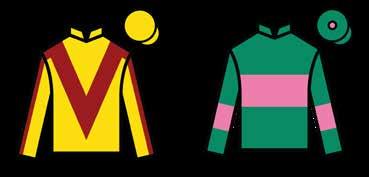


WRITTEN BY L.A. BERRY
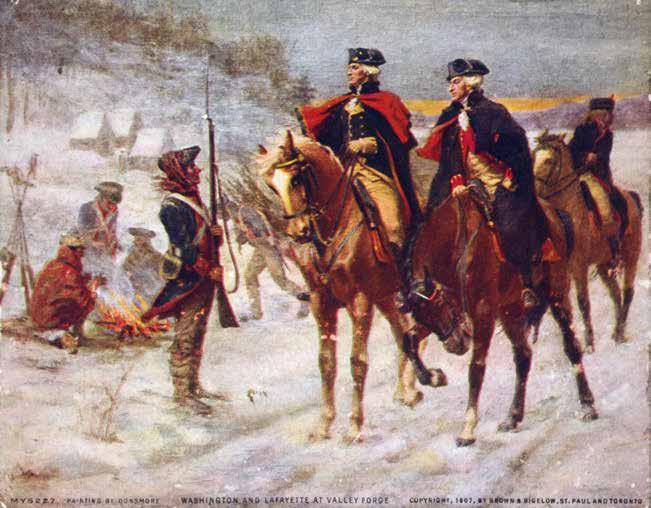
An anonymous writer but likely animal lover penned,
“The dog may be man’s best friend but the horse wrote history.”

With this summer marking the 250th anniversary of “America’s Turning Point,” the Battles of Saratoga at Bemis Heights and Freeman’s Farm, where the course of the revolution was changed, it is a good reminder of a key partner throughout that early colonial history: the horse. Saratoga is synonymous with health, horses, history not only for its c. 1863 race track, but because horses and their equine kin were essential to the success of a nascent nation’s transportation, agriculture, and military.


a Colonial
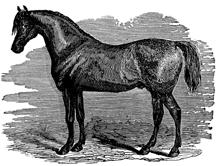
The Norfolk Trotter, or Roadster, was a good “general purpose horse” according to (and image from) the 1883 Brett’s Colonists Guide.

Narragansett Pacer, 1895 illustration from American Horses and Horse Breeding, J. Dimon, published Hartford, CT. Credit: Flickr, Internet Archive Book Images
“Horses in North America were more likely driven than ridden,” cited M.E. Derry in Horses In Society: A Story of Animal Breeding and Marketing Culture (1945). “The majority of gentlemen in Canada and the United States preferred to drive rather than ride, and for that reason never favoured the pure Thoroughbred to the same degree as British horsemen.”
This dichotomy defined light-horse trading between Britain and Colonial America. In pursuit of lighter horses to put to harness, North American breeders looked for trotting/pacing talent in crosses with British Norfolk Trotters, or Narragansett Pacers from Vermont and New York whose lineages traced to Rhode Island and the horses imported between 16291635 by the Dutch and English.
In its own look at horse history, Return to Freedom Wild Horse Conservation says animals identified as Canadian, French, or Norman were in the Great Lakes region when a 1782 census at Fort Detroit listed over 1,000 animals. “By 1770, there was a clear zone from Ontario and Saskatchewan to St. Louis where Canadian-type horses crossbred and were allowed to roam freely.”
“A second critical difference,” Derry added, “in North American lighthorse breeding when compared with breeding the Thoroughbred in Britain, was the emphasis on ‘type’ and ‘line’ over ‘breed.’ No pedigree system existed. The ideas of ‘blood’ and
‘purity’ were absent in the production of these early trotters/pacers.”
Breeding for bone over bloodline shaped the horsepower that was harnessed to stagecoaches of entrepreneurial tavern owners like Levi Pease, who launched the nation’s first successful longdistance stagecoach service and postal routes (shaving delivery time between Boston and New York City from six days to 36 hours).
“During the time of the Revolutionary war a large accumulation of data bearing on the size and action of horses of that period goes to show the average size had increased to 14 hands and one inch, and in gait 15 [horses] paced and trotted, nine trotted only, and seven paced only,” cited Trotting Register founder John H. Wallace in his 1897 Horse Of America In His Derivation, History and Development, Including the Horses of the Colonial Period, Hitherto Unexplored. “Strains of larger breeds had been introduced but the little New England pacer made his mark on the habits of action.”
Exchanges of robust driving types like the Royal George, St Lawrence, and Clear Grit across AmericanCanadian borders produced solid stock and anchored Albany as a transportation hub for stagecoaches including -- according to New York State Historic Markers in Saratoga County – those headed north to the public house and blacksmith shop of Saratoga’s first permanent settler, Alexander Bryan.
In Troy, NY, there were 100 stagecoach arrivals and departures each week over a system of stage-lines instituted by Captain Pease, demonstrating it was no visionary scheme to end in financial disaster, as he was told by those asked to join his undertaking in 1783.
Credit: Worcester Society of Antiquity
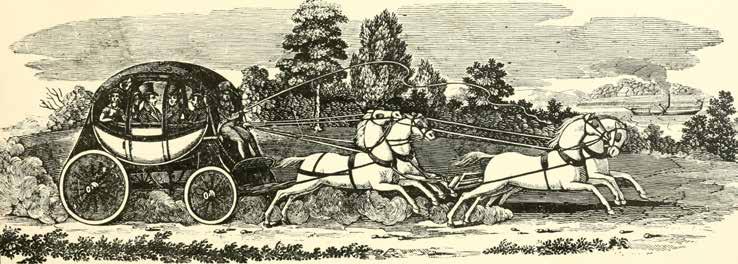
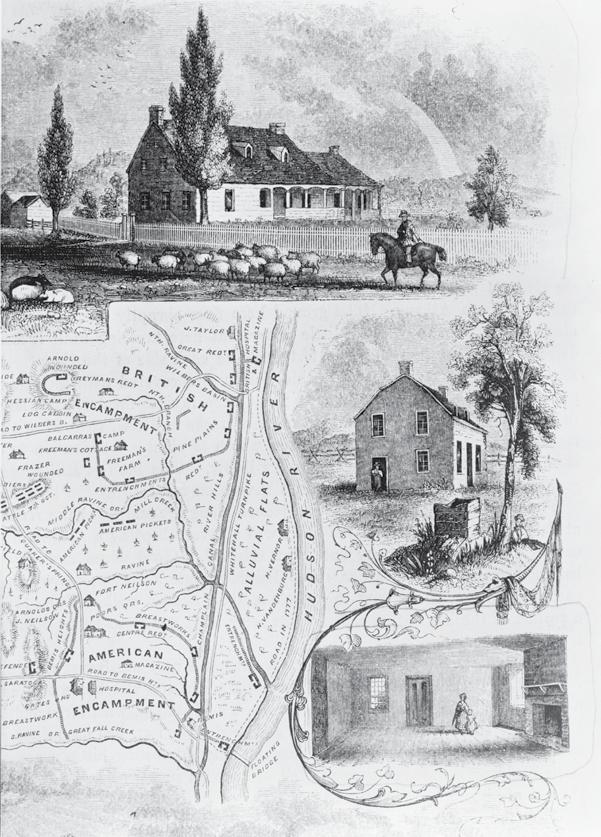

Bemis Heights (John Neilson House), Stillwater, Saratoga County. Print from Benson Lossing’s Pictorial Field Book of the Revolution, 1851, p.48, plans of battlefield and views of frontier settlement house from south, east and inside.
Credit: Library of Congress
“From the fields of colonial farms to the bustling streets of industrializing cities, horses played a pivotal role in shaping the U.S. economy, transportation, and culture. Their strength turned soil, their speed carried messages, and their resilience moved entire industries forward,” noted Greenwich, New York-based agricultural news source, Morning Ag Clips.
Draft horses rivaled oxen as the best choice for farm work but horses proved faster, more versatile, and easier to manage, allowing farmers to plow larger fields and transport goods more efficiently. This was important because, by the first U.S. Census of 1790, the Minnesota Libraries Publishing Project says 90% of the post-Revolutionary population listed their occupation as “farmer.”
“The development of improved harness and farm equipment, such as horsedrawn plows and seed drills, enhanced agricultural productivity. Horses,” MAC said, “were indispensable for transportation, enabling movement of people, goods, and information across increasingly vast distances. Stagecoaches and wagons pulled by sturdy horse teams were vital for trade and communication, especially in rural and frontier areas.”
Horses were integral to another 18th century endeavor: logging. North of Saratoga, the brothers Ebenezer and Edward Jessup moved logs off the Hudson River onto horse-drawn wagons for local deliveries (until the staunch Royalists fled to Canada at the onset of the Revolution). Harvesting ice also lined farmers’ pockets in the off-season, as horse-drawn wagons took blocks of ice the New York Times described as “ten inches thick” to storage houses packed with insulating sawdust.
I am much oblig’d to you
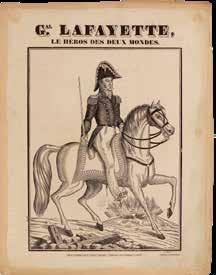
One well-known horse of the American Revolution was the Marquis de Lafayette’s Ajax. In 1778, while returning to France to secure aid, he entrusted Ajax to his Commander-inChief, George Washington. The National Archives have his horseman’s thank-you: 25-26 August 1778
My dear general, I am much oblig’d to you for the Care you are so kind as to take of that poor horse of mine – had he not find such a good stable as this of head quarters he would have cut a pitiful figure at the end of his travels, and I would have been very happy if there had Remain’d so much of the horse as the bones, the skin, and the four schoes.
I have the honor to be your Excellency’s most obedient humble Servant
The Mis de lafayette
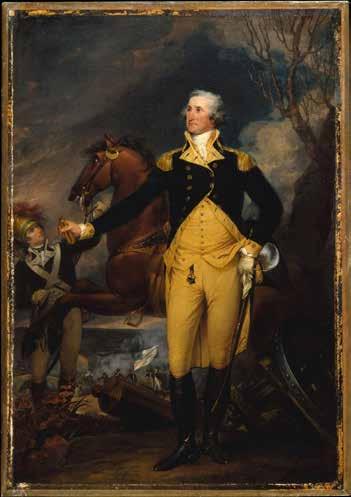
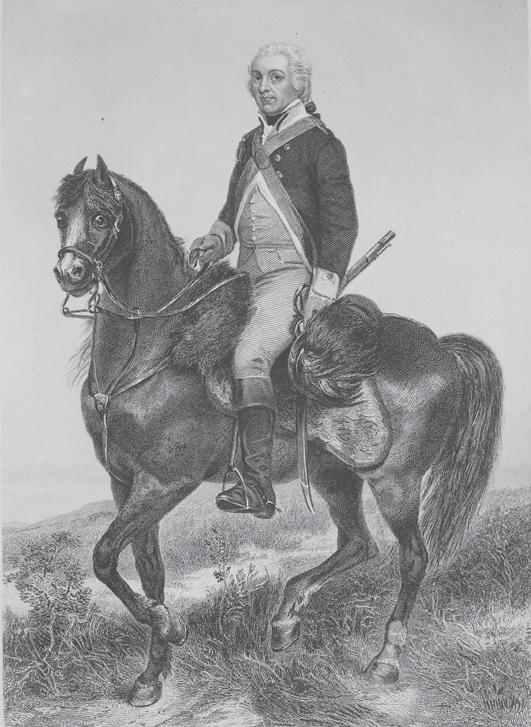
Credit: Metropolitan Museum of Art Collection

“Light-Horse” Harry Lee. Artist unknown. Credit: US National Archives
The American victory at Saratoga and surrender of General Burgoyne’s army was deemed “the most important battle ever fought in the world in the last 1,000 years” by New York Times Magazine chief correspondent R.W. Apple, convincing France to ally and bringing resources to empower the colonies toward independence.
But it did not come with horses.
“Since the attrition rate was high for bringing horses across the seas, it made more sense to use American horses,” wrote Daphne Reznik in Equine Lessons From the Courthouse Green: Insights on Horses in the American Revolutionary War.
“You needed to have a horse to be part of any unit utilizing them for the American cause. One course for horses were horse agents; they were the middlemen between horse owners and the military leaders who supplied the soldiers.”
It is estimated that the American Revolution claimed the lives of 25,000-50,000 horses and mules, conscripted through the kind of transaction and sacrifice Michael Morpurgo portrayed in his children’s book, War Horse:
“No splints, not lame, good feet and teeth. Buy him, Captain. He’s a good one.”
I was led back to Albert’s father who took the offered money from Captain Nicholls, stuffing it quickly into his trouser pocket. “You’ll look after him, sir?” he said. ”You’ll see he comes to no harm? My son’s very fond of him, you see.”
Travis Shaw, in his Cavalry of the American Revolution for the American Battlefield Trust, says the Continental Army began the war “with almost no cavalry to speak of” but by its end had made horses and horsemen into household names.
George Washington’s battle partner was known to be a chestnut gelding named Nelson. Casimir Pulaski, after fighting Russian domination in his native Poland, joined the Revolution and became the “Father of the American Cavalry,” and “Light-Horse” Harry Lee was called the finest cavalry officer in the Continental Army.
Zooarchaeologist Sandra Olson, who studies horses and their impact on society at the American Museum of Natural History in New York City concludes, “Horses provided the first means of fast travel. They sped up migration, trade, and communication between cultures. They helped people do work, from plowing fields to hauling goods. And contributed to human status, religion, and sports.
“Horses have made a bigger impact on human society than any other animal.”


WRITTEN BY BILL ORZELL
The Saratoga Springs resort, made popular by healing mineral waters that are part of Native American lore, saw thoroughbred horse racing introduced in 1863 on a track presently part of Horse Haven. The inaugural race meet was so successful that the following summer the plant was relocated to its present site, with its larger grounds on the south side of Union Avenue. The group of pioneering sportsmen behind the effort, who were also successful in business, recognized the opportunity and potential at the track as a good gamble, and incorporated in 1865. As racing spurred breeding, the placing of wagers was tolerated, and the group named their new corporation “The Saratoga Association for the Improvement of the Breed of Horses.” The group furthered betting interests with the operation of a clubhouse that functioned as a casino, which operated behind a veneer of respectability for those “in the know.”
The shareholders of the track continually poured their revenues into the facility, and the racing contributed toward the then village’s economy, and was supported in turn by the established resort infrastructure. Spectators were accommodated at the track in a modest wood structure similar to those at many county fairgrounds. A grandstand with incremental stepped seating levels and a simple gable roof provided better race viewing, and cover from sun and shower. This building was constructed by local craftsmen, and it was repeatedly improved and augmented, as the reputation for great racing increased the popularity of the meet over a span of nearly three succeeding decades.
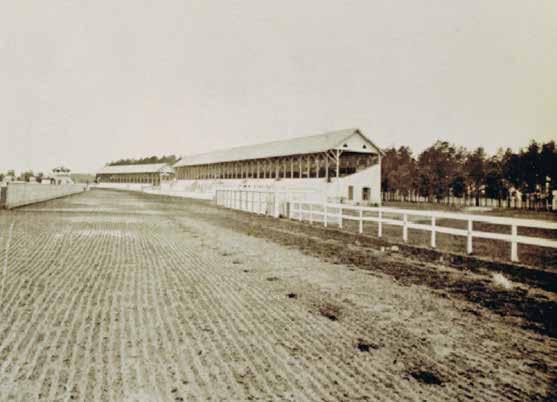
By this time many of the original incorporating shareholders of the Saratoga Association had passed away, and the casino had come under increased scrutiny for its principal shareholder, Albert Spencer. With a single controlling interest, several scribes were quick to point out that the “Saratoga Association, was an association in name only.” Rumors, which seem to especially permeate race tracks where the patrons are always seeking an edge, abounded in discussion about a change in ownership. Tales of this sort were a common conjecture in polite conversation, as everyone who visited had an interest. This prospective sale discussion bore more credence than in the past, as Mr. Spencer, the majority stockholder, had earlier sold his very profitable clubhouse/casino enterprise to Richard Canfield. Also, the prospective principals in the projected deal were noted racing men of unlimited capital: Pierre Lorillard, August Belmont, Senator George Hearst, D.D. Withers, John A. Morris, A.J. Cassatt and W.L. Scott, with the syndicate headed by publisher William J. Arkell.
Mr. Arkell, whose own fortune was made in publishing a host of daily newspapers and the very popular Judge Magazine, along with Frank Leslie’s Illustrated Newspaper, had very strong ties to Saratoga County. He also operated the Hotel Balmoral there, at the same Mount McGregor location where the Drexel Family and Mr. Arkell provided the cottage used by former President U.S. Grant to compose his memoirs shortly before his demise.
The original grandstand at Saratoga Race Course c. 1860s.
Credit: The George S. Bolster Collection
The Spa: Saratoga's Legendary Race Course can be purchased in-person at the Saratoga Springs Preservation Foundation office, 112 Spring Street, Suite 203, or online at www.saratogapreservation.org
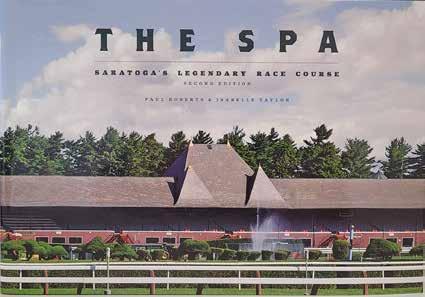
The 1890 track season ended in Saratoga, and when the leaves were down as autumn transitioned to the frigid season, it was announced that all the officers and trustees of the Saratoga Association had been replaced by members of the Arkell syndicate, indicating an orderly property transition. As so often occurs in the thoroughbred racing world, the expected failed to materialize, mostly due to the unforeseen deaths of August Belmont and Senator Hearst. Many daily publications during the winter of 1891 lamented the collapse of the transfer of the Saratoga Racing Association to the Arkell group, but indicated that the important changes and improvements projected would all be carried out as planned.
It is conjectured that the soon-to-be new owners moved beyond planning, with several modifications to the racing plant before the deal was closed. Indeed, several contracts let by the Arkell syndicate, such as the construction of a new betting ring by Saratoga’s master builder Andrew Robertson, were honored by Albert Spencer. Turnberry Consulting associates Paul Roberts and Isabelle Taylor in 2011 published in The Spa-Saratoga’s Legendary Race Course that perhaps the parameters for the classic grandstand, with its iconic slate roof and unique turrets with copper apex, were established by the Arkell group.
With the Arkell syndicate deal lost, Albert Spencer accepted another offer, and a paradigm shift occurred when the notorious Gottfried Gottlieb Walbaum purchased the Saratoga Race Course in August of 1891. This deal was brokered by Paul Grening, the proprietor of the Kensington Hotel on Union Avenue at Regent Street, with him becoming an officer of the transferred Saratoga Association. Not all welcomed Mr. Walbaum in Saratoga, as his operations at the Guttenberg Race Track near Weehawken, New Jersey were more than suspect. He frightened the racing business with this operation only a ferryboat ride from Manhattan. Operations at “The Gut,” were a black mark for the turf, where winter racing was staged with little concern for equine athletes or jockeys. The Brooklyn Eagle did not mince words,
“The knell of doom has sounded for high class racing at Saratoga. Guttenberg has laid grimy hands upon it. Not satisfied with their illicit gains from winter racing the Guttenberg guerrillas propose to raid upon a New York track for thirty days of summer racing. . .The plagues of Egypt would be easier to bear.”
In late November of 1891 the Saratoga Association contingent, headed by G.G. Walbaum, met for a site review with H. Langford Warren, and discussed a contract for construction for a new clubhouse and grandstand complex. Given the limitations of 1890s design work, it would stand to reason that Architect Warren “caught a flyer out of the gate” on his proposal, perhaps having been contacted originally by the Arkell group. This same timeline neatly fits with author Maureen Meister’s conjecture in her book Architecture and the Arts and Crafts Movement in Boston- Harvard’s H. Langford Warren, which compares Warren’s Saratoga clubhouse/grandstand design elements to the South End Grounds baseball pavilion in Boston, opened in the spring of 1888. This ballpark, which housed Boston’s National League Club, had a very short existence, being torched accidently by children in 1894.
It seems surprising that Mr. Walbaum, who was variously referred to as Gus, George, or more derisively “Dutch Fred,” did not protect the large investment he made in the race track plant with sound management. He functioned in Saratoga as track operator, stable owner, bookmaker and faro dealer into the early hours of the morning. He offended many horsemen and punters by reducing purse structures. Walbaum’s voice spewed profanity through his thick Teutonic accent, getting himself generally disliked by his dictatorial acts, and preferring to defy public opinion. He angered local merchants and bookmakers by changing the start times of the race card. Walbaum carried out a pitched battle with the Jockey Club for years, and used the Saratoga race dates as a weapon, resulting in the cancellation of the entire 1896 season. The legendary gentleman jump jockey Harry S. Page described those days as “squalid,” and further stated that Walbaum’s sport, was “mostly indoor, unfortunately.”

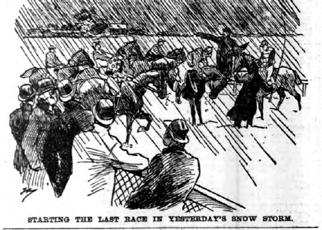
It is believed
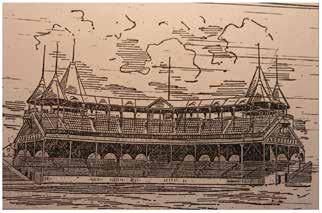
Warren-designed original Saratoga clubhouse with 2-story piazza and conical turrets in the foreground, grandstand with pyramidal turrets center, and betting ring far right. Configuration following the 1902 track revision, where these three structures were relocated. Credit: Library of Congress, Call Number 2016804084.
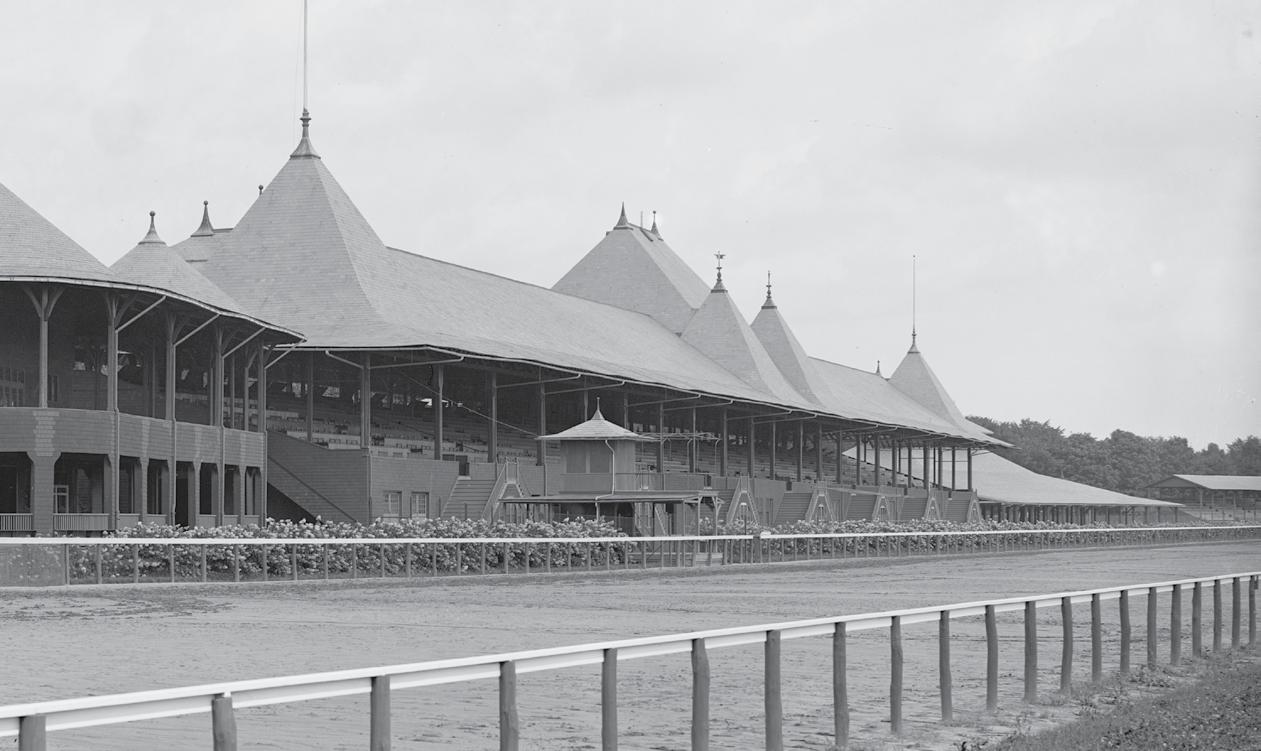

Certainly Gottfried Walbaum is never fondly recalled in Saratoga Springs, as his ignominious operations seriously imperiled racing at the Spa. It took the foresight of Richard T. Wilson, recently re-honored with his name on the mile course, to form a syndicate of interested sportsmen including William C. Whitney as President, to buy out Walbaum’s interests in late 1900 and expel his injudicious methods. However, all of us who admire Saratoga’s very recognizable stately crown, must bear in mind that Mr. Walbaum made this reality happen.
The Whitney and Wilson-led Saratoga Association began their operation of the track in 1901. Following that season, extensive changes were made by the Empire City track designer Charles Leavitt, increasing the size of the oval and repositioning its orientation on the grounds. This involved moving all the buildings on the property, with the clubhouse, grandstand and betting ring relocated. To accomplish the rearrangements the grandstand was separated into three sections, and reset as separate units, with the areas between becoming major additions which increased the overall length of the structure. Just prior to the opening of the reconfigured track in June of 1902, the local Saratoga Association office was destroyed in the Arcade Building fire with a regrettable loss of life, along with many irreplaceable records of the recent rebuild.
Through the succeeding years further alterations were made, with the Warren-designed clubhouse and its delightful 2-story veranda and conical turrets replaced in 1928 by the present multi-tiered turf terrace designed by Samuel Adams Clark. The betting ring, inactive since the introduction of pari-mutuel wagering in 1940, was torn down in 1964, replaced by a 550-foot addition to the east side of the grandstand, which attempted to include Mr. Warren’s roof treatments. Architect Arthur Froelich and assistant Robert Krause ordered installation of new slate over both old and new structures.
Gottfried “Dutch Fred” Walbaum remains persona non grata in Saratoga Springs after his appalling management diluted the quality of racing at the Spa, yet he made our treasure come to life. Since his time, the Victorian gem has taken on its instantly identifiable appearance, decorated with sculptured finials in a warm patina of tarnished copper, which so many fans of racing in Saratoga find a joy to behold. Saratoga Race Course is instantly recognizable by its iconic roofline and unique treatment. The Gilded Age survives to our time through the turret-spiked, finial capped, slate roof of the grandstand. The distinguished noble crown of racing’s dowager queen places one instantly at the Spa, in the foothills of the Adirondack Mountains, and announces “Saratoga Springs.”
INTRODUCTION WRITTEN BY CAROL GODETTE • PART II •
Driving by 148 Union Avenue, one hardly notices the stately three-story white clapboard house with green trim. The building is tucked into a corner surrounded by a black iron fence and shrouded with shrubbery, marked by a small sign on the front screen-"SARATOGA READING ROOM.” Originally intended as a private social club for men only, The Reading Room was founded for Thoroughbred horse owners, trainers and breeders to read the daily racing papers before crossing the NYRA grounds for the afternoon racing. It later became an exclusive dining club serving breakfast, lunch and after-race cocktails for its members. Few local residents ever entered the building, unless they were there to work. From 1972-1989 The Reading Room’s kitchen and dining rooms were staffed by a group of young black athletes living on the west side of Broadway, which they referred to as the “Best Side” of Saratoga.
Ernest “Sonny” Gooden, a 6”2” basketball star at Saratoga High School began as a dishwasher in the Reading Room due to his father’s job at the track. As positions in the Reading Room opened up, Sonny would recommend neighborhood relatives and friends. Two dish-washing positions became available and Sonny recommended his friend Eddie Pinn and his cousin Stewart White.
“We had fun and made lots of money,” reflects Stewart. Both teenagers knew if they worked hard, they could make serious money by being promoted to waiters. Within a few years, both were wearing the coveted white jackets of a Reading Room waiter. That’s when they got to meet people that may never have otherwise crossed their paths.
For both Sonny and Stewart, the job was really about the relationships they built with the regulars. “We were so comfortable around them and they were equally comfortable around us,” said Stewart.
In today’s world where stories of racism and prejudice are all too frequent, Sonny and Stewart didn’t experience any of this at the Reading Room. “Our boss wouldn’t stand for any disrespect. Once someone who came for sales week was disrespectful and the maitre d’ sent them packing. He had to apologize to us, or his membership would be revoked,” they both stated.
Pittsburgh Pirate owner John Galbreath and horse trader Stanley Petter were just a few of the patrons who were interested in Stewart's and Sonny’s personal lives. “We were all playing ball at the time, especially Sonny ‘cause he was the MAN,” jokes Stewart-referring to Sonny’s success on Saratoga High’s basketball court. (When Sonny was inducted into the Capital District Sports Hall of Fame, he was described as the best basketball player Saratoga High ever had.)
“The people at the Reading Room got us ready for college. They went out and bought some of our stuff like trunks and supplies,” they fondly recall.
Stewart, Sonny and their friends worked hard and were good at what they did, always going the extra mile for their favorite patrons. Stewart describes the job as a “match made in heaven.” Eventually Stewart’s brother James was also hired. When James passed away two years ago, it inspired Stewart to document their experiences in the story “Saratoga’s Best Kept Secret.”
Equicurean is honored to bring you the second installment…


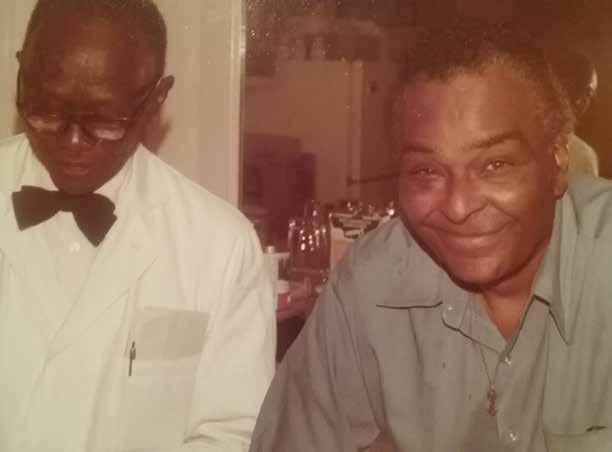
One thing about the members of the Reading Room, they loved the simplicity of the club. Not a lot of extravagance. They enjoyed arriving at their tables and seeing the same faces. They seemed to enjoy seeing someone they trusted taking care of their needs. Trust was very important. Once you established their trust, it was like a match made in heaven.
The staff of the Reading Room consisted of some old timers. As young whippersnappers, we marveled at the older men and energy they had. There was our boss, Otis Buggswho actually - was a bit intimidating. He was a short, older man whose job was to make everything the members wanted, happen.
The ladies who prepared the food for the members during the early years were named Lucille and Helen. Helen had roots in South Carolina, and Lucille was from NYC. Boy could they cook and bake. I used to love the peach cobbler Lucille used to make.
The servers during this period of time in the 70s were Mack, Tom, Bill, Fred, and Hickenbacher or Hick. All the waiters had the same traits, older black men with a crazy work ethic.
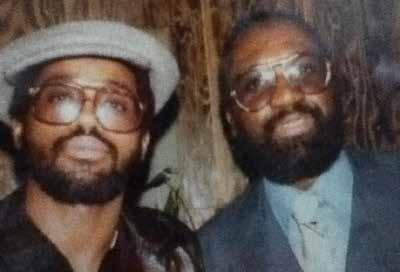
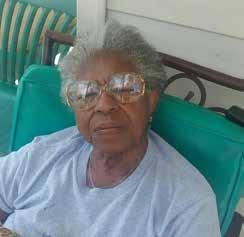
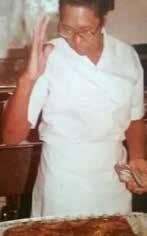
Mack probably was in his 60s - he was a server but did the work of a valet for the live-in men. He would pick up the dry cleaning for members and run errands for them during the downtimes. Bill was a server who was one of our favorites. He was not as intimidating to us as Otis and Mack. Bill was from Philadelphia. I used to love his thick handle bar moustache. Bill used to be an excellent basketball player. He was a younger man than the rest of the wait staff; he was in his 40s. I think that’s why we related to him. As a matter of fact, we loved listening to him tell his exploits at basketball games in Philly. Our favorite stories were about playing basketball and growing up with Wilt Chamberlain. Plus, he was kind of - to us - just a plain ole “cool dude”.
Tom, from NYC was the brother of Frankie who served as the housekeeper for the members who stayed in the rooms upstairs. Tom would eventually take Buggs’ place as the person in charge of the staff and the person in charge of handling the special needs of the members. Tom was very skilled. He had worked the railroad as a server and we watched him carefully, as I hoped that one day, we might get our chance to become servers at the Reading Room. Another server whom we watched closely, and we thought was probably the hardest worker and most skilled of them all, was a man named Fred. Fred was a tall, thin, dark skinned man who was from the south. He was probably in his early 60s at the time. Now, if you’re talking about a man who could
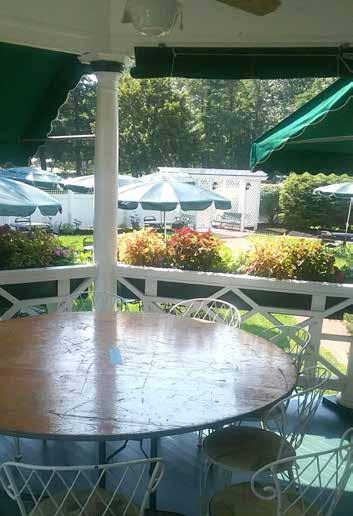
work, it was Fred. Fred had more of a “yes massa” way about him than the others. I later found out that Fred was part of the famous, historical group of professional black porters known as Pullman Porters. They worked on the railroad. It was the porter that gave the sleeping car that feeling of luxury for the wealthy. They were there to serve the very fortunate. That explained why Fred looked so very professional.
Then there was an elderly server we called Hick. His last name was Hickenbacher. I didn’t know a lot about Hick. One thing I did know was he had the gout and it caused him to have problems with his feet. I remember when my cousin Sonny stepped on his foot by accident. He was in such pain. I knew he wasn’t going to last long as a server with those bad feet.
Lastly, I want to introduce to you the two sweetest ladies that were part of these special and extraordinarily group of hard workers. These ladies happened to both be named Frankie; Frankie Johnson and Frankie Romaine. Frankie Johnson, the younger sister of Tom, was a short, chunky, freckle-faced woman who took care of the housekeeping for the male members who stayed in the rooms. She made the beds, changed linens, and kept them supplied with clean towels and bathroom products. Frankie had been the housekeeper at the Reading Room in the neighborhood of 30+ years. She would also help as a server on days we were really busy and needed that helping hand. I got a kick out of her because she used to refer to us as her “little boys.” Sonny was 6’2, I was 6 feet, but to her, we were her little boys.
I can still hear her high-pitched voice calling us to do something she needed done. For a long time, it seemed like I could hear her calling my name in my sleep. All the members loved Frankie Johnson. We used to love listening to her many stories of her exploits during her younger days growing up in NYC and at the Reading Room.
Frankie used to supervise us during the setup of the upstairs rooms before the Reading Room opened for the members. She used to go through the rooms with a white glove making sure we had dusted. She was very meticulous and wanted things done right. There was no hiding or getting away from her. Even with all our little hiding spots we had as young boys, that high pitched voice of hers would reach us. As I said, there was no escaping Frankie Johnson!
Frankie had close relationships with the wives and female guests of the members. She was another one who we noticed was pocketing lots and lots of money from the lady members. Matter of fact, she used to flash the $20s, $50s- or $100-dollar bills, she had just received. She knew everyone, their families, what they did, and she treated everyone as if they were her best friend. Frankie got sick in the late 90s and last I heard she was in a better place. God bless you Frankie. You were a great lady.
Now Frankie #2, as she was known to some members, was in her early 60s, she came on during the late 70s and was one of the last of the black staff that remained into the 1990s before she retired from working.
Frankie was a local woman who lived in our neighborhood in Saratoga Springs. A little-known fact is that her daughter Toye - who sadly passed away in 2009, at the young age of 53 and periodically helped out at the Reading Room - was my first ever girlfriend. We were in the 7th grade. She was the first girl I ever kissed. A funny thing about that was, I must have been a terrible kisser. She broke up with me shortly after.
Mrs. Romaine knew all of us as we grew up through the years. As Frankie Johnson’s assistant, she had the same traits. She was very meticulous, very detailed, and wanted things done correctly the first time.
So that is my introduction of the older guard, who during the upcoming years started fading into their twilight years. They would come up from time to time to visit, eat some of Lucille and Helens cooking and go to the track. After three years of washing dishes, the door of opportunity was finally opening for a couple of young, upstanding, eager young bucks who were primed and ready to replace the old guard. It was finally our time to shine. The arrival of the young bloods as servers was upon us. We called ourselves the New Breed and in 1975, we couldn’t wait to get started.
In
the next installment, we’ll meet “The New Breed”
